Inside Aztec
Inside
Aztec
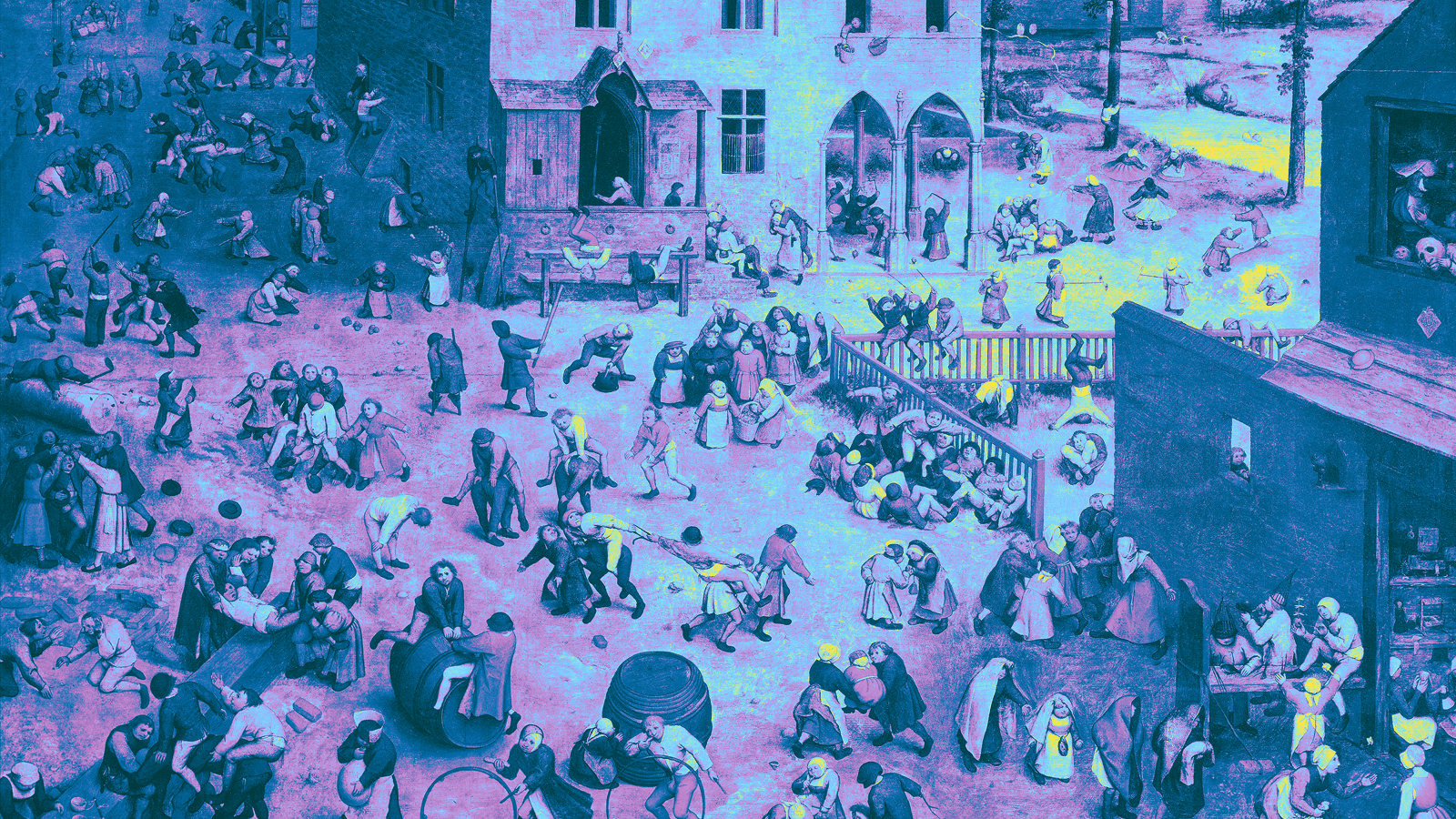

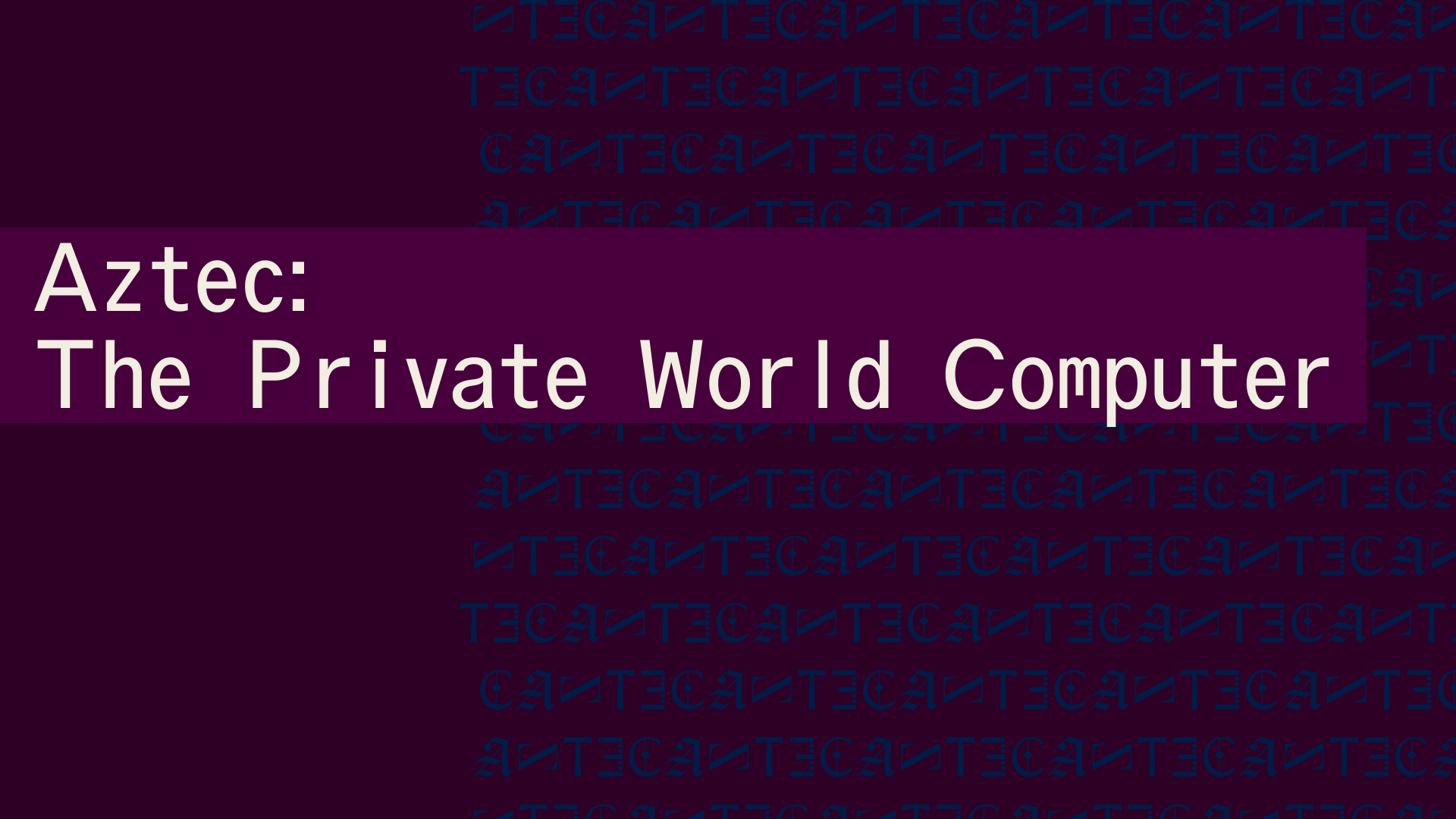
Building a fully decentralized, privacy-preserving network to unlock the next Renaissance.
Privacy has emerged as a major driver for the crypto industry in 2025. We’ve seen the explosion of Zcash, the Ethereum Foundation’s refocusing of PSE, and the launch of Aztec’s testnet with over 24,000 validators powering the network. Many apps have also emerged to bring private transactions to Ethereum and Solana in various ways, and exciting technologies like ZKPassport that privately bring identity on-chain using Noir have become some of the most talked about developments for ushering in the next big movements to the space.
Underpinning all of these developments is the emerging consensus that without privacy, blockchains will struggle to gain real-world adoption.
Without privacy, institutions can’t bring assets on-chain in a compliant way or conduct complex swaps and trades without revealing their strategies. Without privacy, DeFi remains dominated and controlled by advanced traders who can see all upcoming transactions and manipulate the market. Without privacy, regular people will not want to move their lives on-chain for the entire world to see every detail about their every move.
While there's been lots of talk about privacy, few can define it. In this piece we’ll outline the three pillars of privacy and gives you a framework for evaluating the privacy claims of any project.
True privacy rests on three essential pillars: transaction privacy, identity privacy, and computational privacy. It is only when we have all three pillars that we see the emergence of a private world computer.

Transaction privacy means that both inputs and outputs are not viewable by anyone other than the intended participants. Inputs include any asset, value, message, or function calldata that is being sent. Outputs include any state changes or transaction effects, or any transaction metadata caused by the transaction. Transaction privacy is often primarily achieved using a UTXO model (like Zcash or Aztec’s private state tree). If a project has only the option for this pillar, it can be said to be confidential, but not private.
Identity privacy means that the identities of those involved are not viewable by anyone other than the intended participants. This includes addresses or accounts and any information about the identity of the participants, such as tx.origin, msg.sender, or linking one’s private account to public accounts. Identity privacy can be achieved in several ways, including client-side proof generation that keeps all user info on the users’ devices. If a project has only the option for this pillar, it can be said to be anonymous, but not private.
Computation privacy means that any activity that happens is not viewable by anyone other than the intended participants. This includes the contract code itself, function execution, contract address, and full callstack privacy. Additionally, any metadata generated by the transaction is able to be appropriately obfuscated (such as transaction effects, events are appropriately padded, inclusion block number are in appropriate sets). Callstack privacy includes which contracts you call, what functions in those contracts you’ve called, what the results of those functions were, any subsequent functions that will be called after, and what the inputs to the function were. A project must have the option for this pillar to do anything privately other than basic transactions.
Bitcoin ushered in a new paradigm of digital money. As a permissionless, peer-to-peer currency and store of value, it changed the way value could be sent around the world and who could participate. Ethereum expanded this vision to bring us the world computer, a decentralized, general-purpose blockchain with programmable smart contracts.

Given the limitations of running a transparent blockchain that exposes all user activity, accounts, and assets, it was clear that adding the option to preserve privacy would unlock many benefits (and more closely resemble real cash). But this was a very challenging problem. Zcash was one of the first to extend Bitcoin’s functionality with optional privacy, unlocking a new privacy-preserving UTXO model for transacting privately. As we’ll see below, many of the current privacy-focused projects are working on similar kinds of private digital money for Ethereum or other chains.
Now, Aztec is bringing us the final missing piece: a private world computer.
A private world computer is fully decentralized, programmable, and permissionless like Ethereum and has optional privacy at every level. In other words, Aztec is extending all the functionality of Ethereum with optional transaction, identity, and computational privacy. This is the only approach that enables fully compliant, decentralized applications to be built that preserve user privacy, a new design space that we see as ushering in the next Renaissance for the space.
Private digital money emerges when you have the first two privacy pillars covered - transactions and identity - but you don’t have the third - computation. Almost all projects today that claim some level of privacy are working on private digital money. This includes everything from privacy pools on Ethereum and L2s to newly emerging payment L1s like Tempo and Arc that are developing various degrees of transaction privacy
When it comes to digital money, privacy exists on a spectrum. If your identity is hidden but your transactions are visible, that's what we call anonymous. If your transactions are hidden but your identity is known, that's confidential. And when both your identity and transactions are protected, that's true privacy. Projects are working on many different approaches to implement this, from PSE to Payy using Noir, the zkDSL built to make it intuitive to build zk applications using familiar Rust-like syntax.
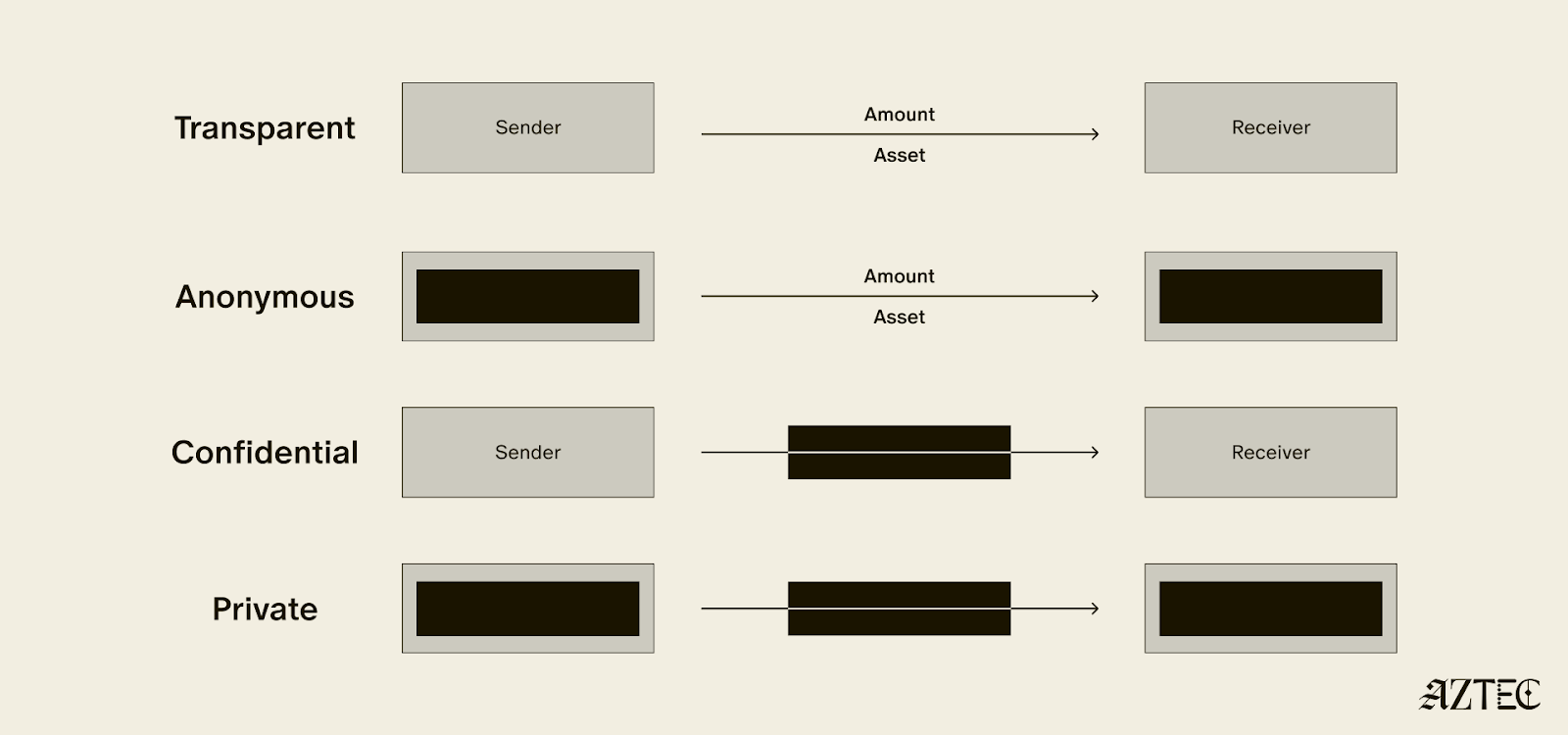
Private digital money is designed to make payments private, but any interaction with more complex smart contracts than a straightforward payment transaction is fully exposed.
What if we also want to build decentralized private apps using smart contracts (usually multiple that talk to each other)? For this, you need all three privacy pillars: transaction, identity, and compute.
If you have these three pillars covered and you have decentralization, you have built a private world computer. Without decentralization, you are vulnerable to censorship, privileged backdoors and inevitable centralized control that can compromise privacy guarantees.
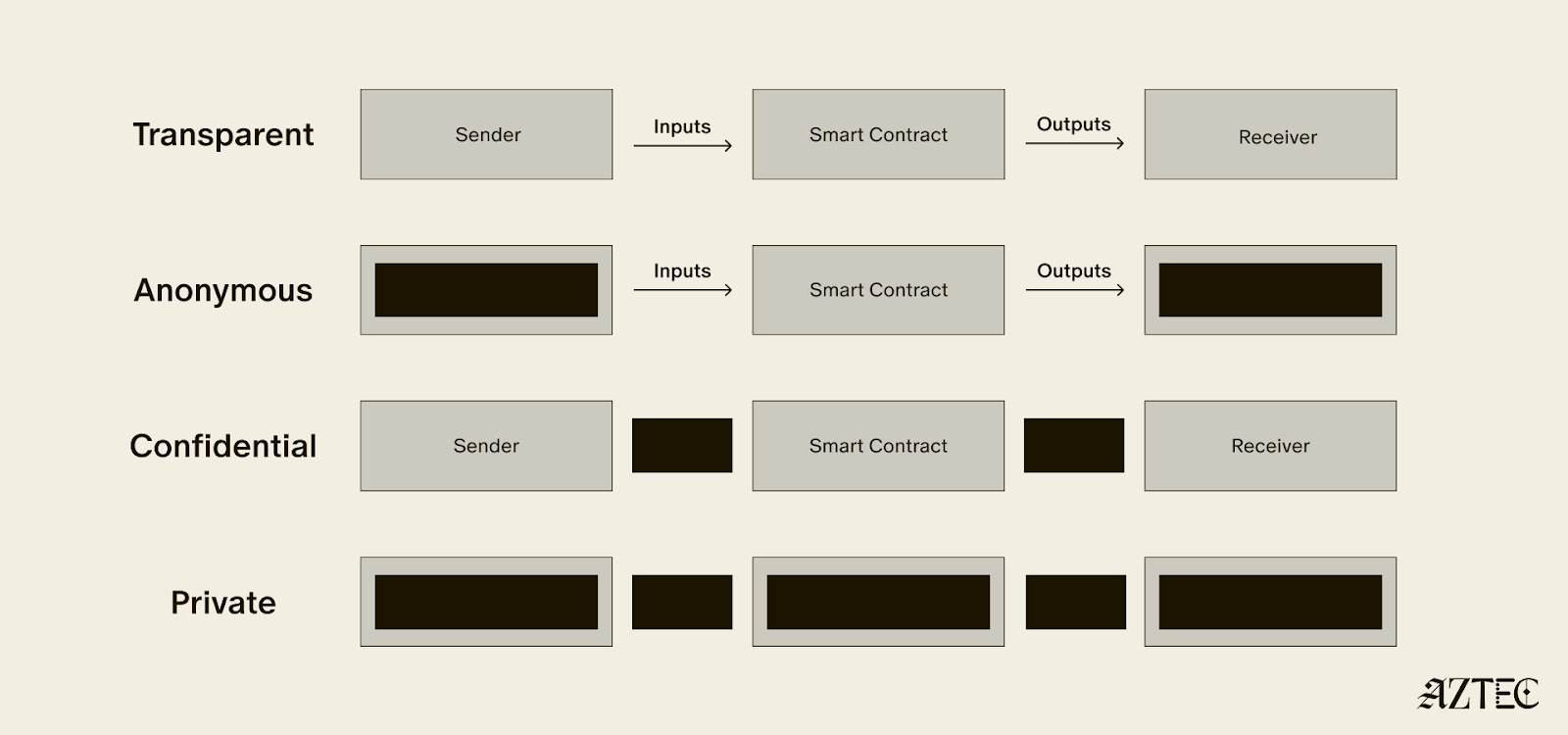
What exactly is a private world computer? A private world computer extends all the functionality of Ethereum with optional privacy at every level, so developers can easily control which aspects they want public or private and users can selectively disclose information. With Aztec, developers can build apps with optional transaction, identity, and compute privacy on a fully decentralized network. Below, we’ll break down the main components of a private world computer.
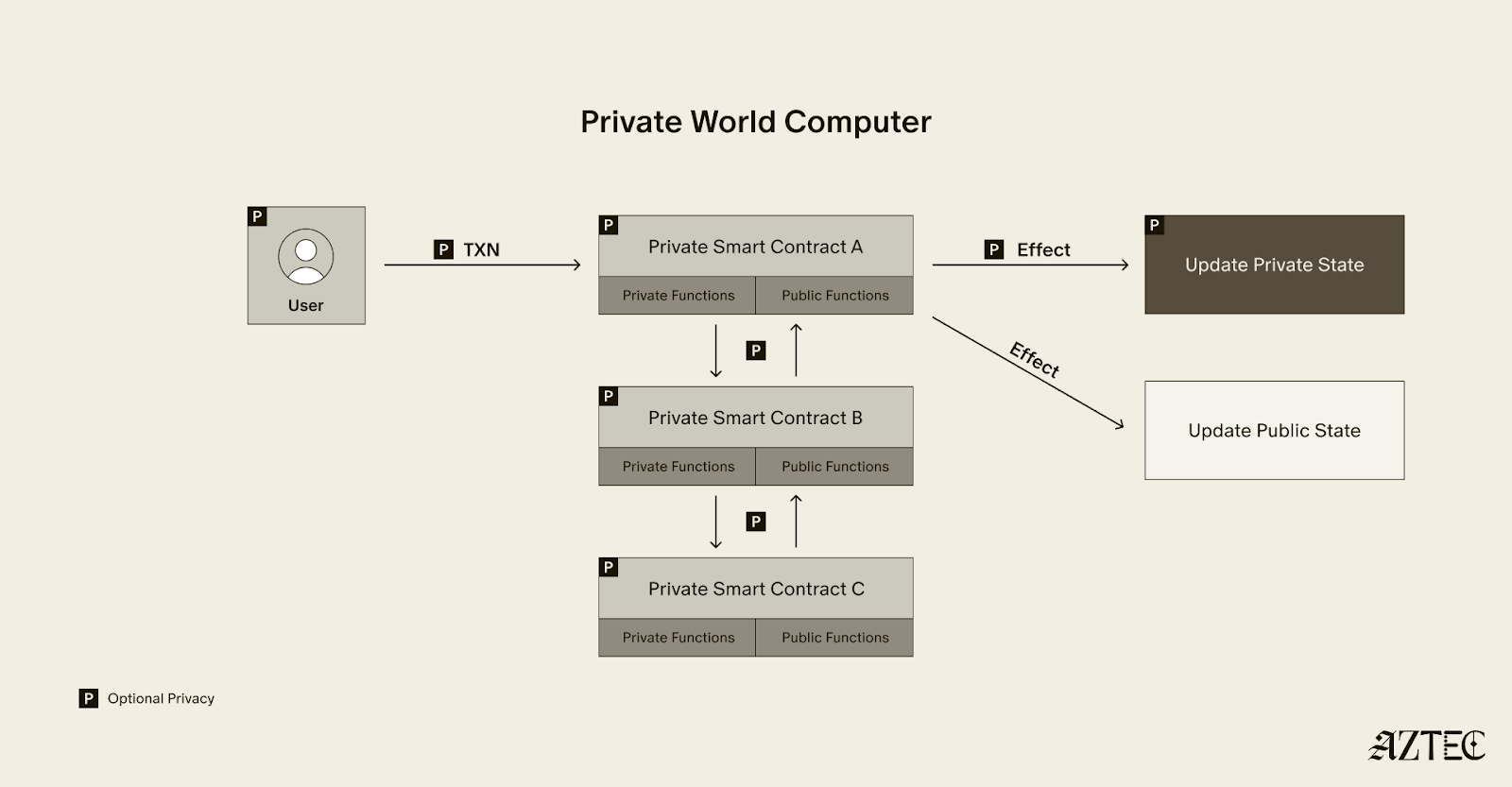
A private world computer is powered by private smart contracts. Private smart contracts have fully optional privacy and also enable seamless public and private function interaction.
Private smart contracts simply extend the functionality of regular smart contracts with added privacy.
As a developer, you can easily designate which functions you want to keep private and which you want to make public. For example, a voting app might allow users to privately cast votes and publicly display the result. Private smart contracts can also interact privately with other smart contracts, without needing to make it public which contracts have interacted.
Transaction: Aztec supports the optionality for fully private inputs, including messages, state, and function calldata. Private state is updated via a private UTXO state tree.
Identity: Using client-side proofs and function execution, Aztec can optionally keep all user info private, including tx.origin and msg.sender for transactions.
Computation: The contract code itself, function execution, and call stack can all be kept private. This includes which contracts you call, what functions in those contracts you’ve called, what the results of those functions were, and what the inputs to the function were.
A decentralized network must be made up of a permissionless network of operators who run the network and decide on upgrades. Aztec is run by a decentralized network of node operators who propose and attest to transactions. Rollup proofs on Aztec are also run by a decentralized prover network that can permissionlessly submit proofs and participate in block rewards. Finally, the Aztec network is governed by the sequencers, who propose, signal, vote, and execute network upgrades.
A private world computer enables the creation of DeFi applications where accounts, transactions, order books, and swaps remain private. Users can protect their trading strategies and positions from public view, preventing front-running and maintaining competitive advantages. Additionally, users can bridge privately into cross-chain DeFi applications, allowing them to participate in DeFi across multiple blockchains while keeping their identity private despite being on an existing transparent blockchain.
This technology makes it possible to bring institutional trading activity on-chain while maintaining the privacy that traditional finance requires. Institutions can privately trade with other institutions globally, without having to touch public markets, enjoying the benefits of blockchain technology such as fast settlement and reduced counterparty risk, without exposing their trading intentions or volumes to the broader market.
Organizations can bring client accounts and assets on-chain while maintaining full compliance. This infrastructure protects on-chain asset trading and settlement strategies, ensuring that sophisticated financial operations remain private. A private world computer also supports private stablecoin issuance and redemption, allowing financial institutions to manage digital currency operations without revealing sensitive business information.
Users have granular control over their privacy settings, allowing them to fine-tune privacy levels for their on-chain identity according to their specific needs. The system enables selective disclosure of on-chain activity, meaning users can choose to reveal certain transactions or holdings to regulators, auditors, or business partners while keeping other information private, meeting compliance requirements.
The shift from transparent blockchains to privacy-preserving infrastructure is the foundation for bringing the next billion users on-chain. Whether you're a developer building the future of private DeFi, an institution exploring compliant on-chain solutions, or simply someone who believes privacy is a fundamental right, now is the time to get involved.
Follow Aztec on X to stay updated on the latest developments in private smart contracts and decentralized privacy technology. Ready to contribute to the network? Run a node and help power the private world computer.
The next Renaissance is here, and it’s being powered by the private world computer.
Special thanks to Santiago Palladino, Phil Windle, Alex Gherghisan, and Mitch Tracy for technical updates and review.
On September 17th, 2025, a new network upgrade was deployed, making Aztec more secure and flexible for home stakers. This upgrade, shipped with all the features needed for a fully decentralized network launch, includes a completely redesigned slashing system that allows inactive or malicious operators to be removed, and does not penalize home stakers for short outages.
With over 23,000 operators running validators across 6 continents (in a variety of conditions), it is critical not to penalize nodes that temporarily drop due to internet connectivity issues. This is because users of the network are also found across the globe, some of whom might have older phones. A significant effort was put into shipping a low-memory proving mode that allows older mobile devices to send transactions and use privacy-preserving apps.
The network was successfully deployed, and all active validators on the old testnet were added to the queue of the new testnet. This manual migration was only necessary because major upgrades to the governance contracts had gone in since the last testnet was deployed. The new testnet started producing blocks after the queue started to be “flushed,” moving validators into the rollup. Because the network is fully decentralized, the initial flush could have been called by anyone. The network produced ~2k blocks before an invalid block made it to the chain and temporarily stalled block production. Block production is now restored and the network is healthy. This post explains what caused the issue and provides an update on the current status of the network.
Note: if you are a network operator, you must upgrade to version 2.0.3 and restart your node to participate in the latest testnet. If you want to run a node, it’s easy to get started.
This upgrade was a team-wide effort that optimized performance and implemented all the mechanisms needed to launch Aztec as a fully decentralized network from day 1.
With these updates in place, we’re ready to test a feature-complete network.
As mentioned above, block production started when someone called the flush function and a minimum number of operators from the queue were let into the validator set.
Shortly thereafter, while testing the network, a member of the Aztec Labs team spun up a “bad” sequencer that produced an invalid block proposal. Specifically, one of the state trees in the proposal was tampered with.

The expectation was that this would be detected immediately and the block rejected. Instead, a bug was discovered in the validator code where the invalid block proposal wasn't checked thoroughly enough. In effect, the proposal got enough attestations, so it was posted to the rollup. Due to extra checks in the nodes, when the nodes pulled the invalid block from Ethereum, they detected the tampered tree and refused to sync it. This is a good outcome as it prevented the attack. Additionally, prover nodes refused to prove the epoch containing the invalid block. This allowed the rollup to prune the entire bad epoch away. After the prune, the invalid state was reset to the last known good block.
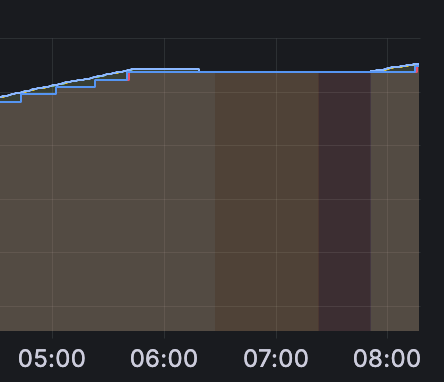
The prune revealed another, smaller bug, where, after a failed block sync, a prune does not get processed correctly, requiring a node restart to clear up. This led to a 90-minute outage from the moment the block proposal was posted until the testnet recovered. The time was equally split between waiting for pruning to happen and for the nodes to restart in order to process the prune.
Validators were correctly re-executing all transactions in the block proposals and verifying that the world state root matched the one in the block proposal, but they failed to check that intermediate tree roots, which are included in the proposal and posted to the rollup contract on L1, were also correct. The attack tweaked one of these intermediate roots while proposing a correct world state root, so it went unnoticed by the attestors.
As mentioned above, even though the block made it through the initial attestation and was posted to L1, the invalid block was caught by the validators, and the entire epoch was never proven as provers refused to generate a proof for the inconsistent state.
A fix was pushed that resolved this issue and ensured that invalid block proposals would be caught and rejected. A second fix was pushed that ensures inconsistent state is removed from the uncommitted cache of the world state.

Block production is currently running smoothly, and the network health has been restored.
Operators who had previously upgraded to version 2.0.3 will need to restart their nodes. Any operator who has not upgraded to 2.0.3 should do so immediately.
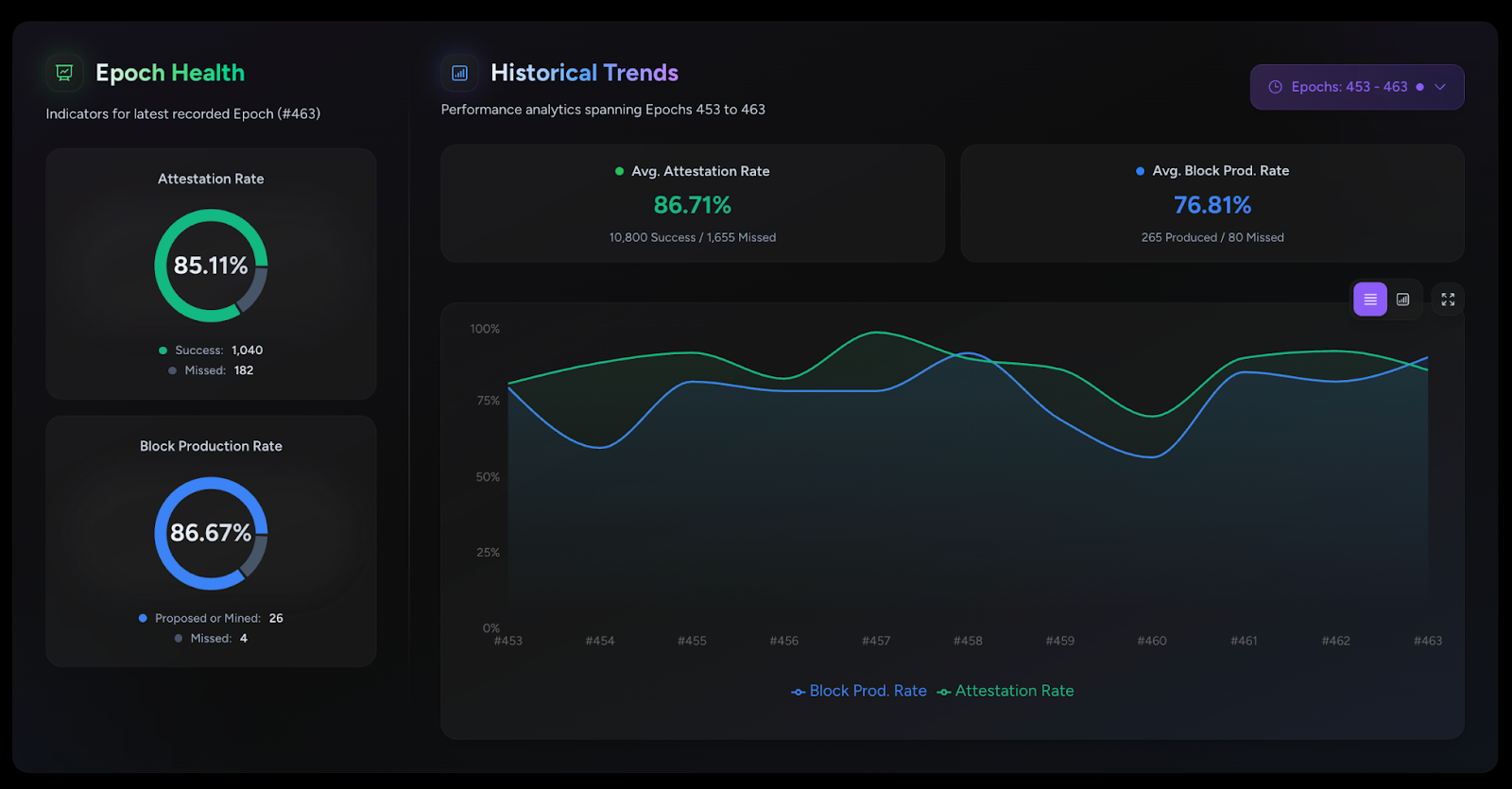
Slashing has also been functioning as expected. Below you can see the slashing signals for each round. A single signal can contain votes for multiple validators, but a validator's attester needs to receive 65 votes to be slashed.
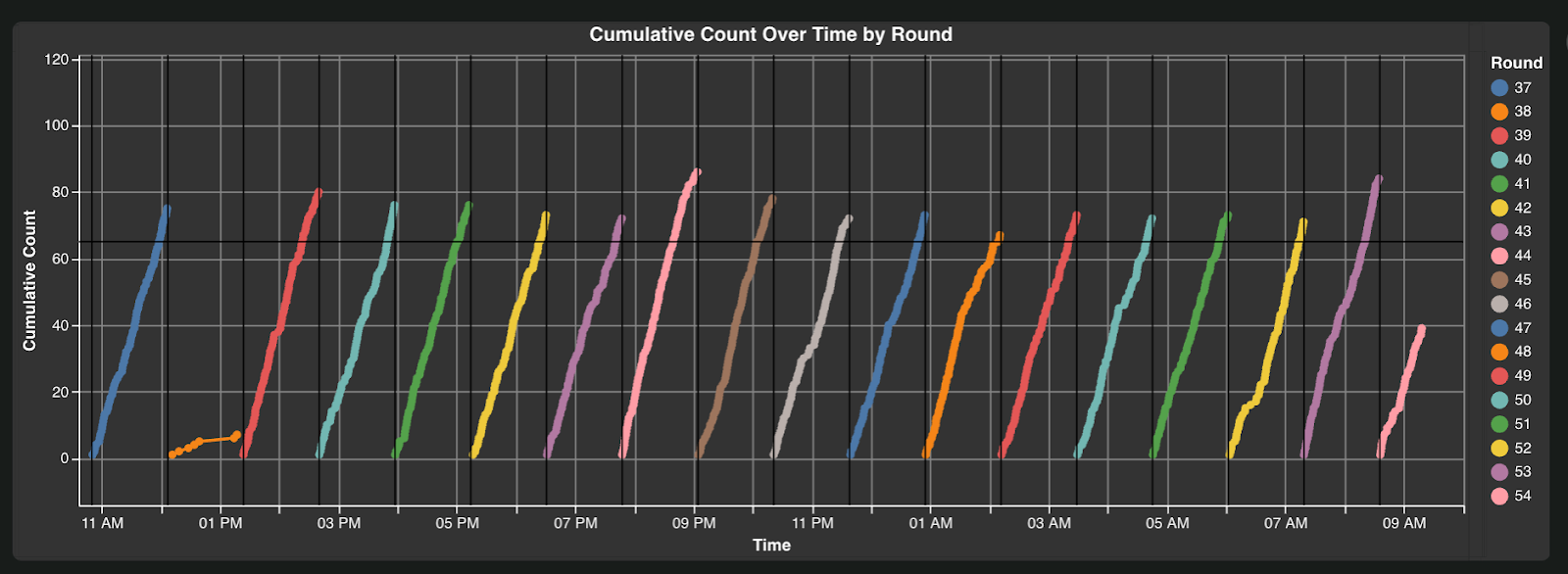
Join us this Thursday, September 25, 2025, at 4 PM CET on the Discord Town Hall to hear more about the 2.0.3 upgrade. To stay up to date with the latest updates for network operators, join the Aztec Discord and follow Aztec on X.
Payy, a privacy-focused payment network, just rewrote its entire ZK architecture from Halo2 to Noir while keeping its network live, funds safe, and users happy.
Code that took months to write now takes weeks (with MVPs built in as little as 30 minutes). Payy’s codebase shrank from thousands of lines to 250, and now their entire engineering team can actually work on its privacy infra.
This is the story of how they transformed their ZK ecosystem from one bottlenecked by a single developer to a system their entire team can modify and maintain.

Eighteen months ago, Payy faced a deceptively simple requirement: build a privacy-preserving payment network that actually works on phones. That requires client-side proving.
"Anyone who tells you they can give you privacy without the proof being on the phone is lying to you," Calum Moore - Payy's Technical Lead - states bluntly.
To make a private, mobile network work, they needed:
To start, the team evaluated available ZK stacks through their zkbench framework:
STARKs (e.g., RISC Zero): Memory requirements made them a non-starter on mobile. Large proof sizes are unsuitable for mobile data transmission.
Circom with Groth16: Required trusted setup ceremonies for each circuit update. It had “abstracted a bit too early” and, as a result, is not high-level enough to develop comfortably, but not low-level enough for controls and optimizations, said Calum.
Halo2: Selected based on existing production deployments (ZCash, Scroll), small proof sizes, and an existing Ethereum verifier. As Calum admitted with the wisdom of hindsight: “Back a year and a half ago, there weren’t any other real options.”
Halo2 delivered on its promises: Payy successfully launched its network. But cracks started showing almost immediately.
First, they had to write their own chips from scratch. Then came the real fun: if statements.
"With Halo2, I'm building a chip, I'm passing this chip in... It's basically a container chip, so you'd set the value to zero or one depending on which way you want it to go. And, you'd zero out the previous value if you didn't want it to make a difference to the calculation," Calum explained, “when I’m writing in Noir, I just write ‘if’. "
With Halo2, writing an if statement (programming 101) required building custom chip infra.
Binary decomposition, another fundamental operation for rollups, meant more custom chips. The Halo2 implementation quickly grew to thousands of lines of incomprehensible code.
And only Calum could touch any of it.
The Bottleneck
"It became this black box that no one could touch, no one could reason about, no one could verify," he recalls. "Obviously, we had it audited, and we were confident in that. But any changes could only be done by me, could only be verified by me or an auditor."
In engineering terms, this is called a bus factor of one: if Calum got hit by a bus (or took a vacation to Argentina), Payy's entire proving system would be frozen. "Those circuits are open source," Calum notes wryly, "but who's gonna be able to read the Halo2 circuits? Nobody."
During a launch event in Argentina, "I was like, oh, I'll check out Noir again. See how it's going," Calum remembers. He'd been tracking Noir's progress for months, occasionally testing it out, waiting for it to be reliable.
"I wrote basically our entire client-side proof in about half an hour in Noir. And it probably took me - I don't know, three weeks to write that proof originally in Halo2."
Calum recreated Payy's client-side proof in Noir in 30 minutes. And when he tested the proving speed, without any optimization, they were seeing 2x speed improvements.
"I kind of internally… didn't want to tell my cofounder Sid that I'd already made my decision to move to Noir," Calum admits. "I hadn't broken it to him yet because it's hard to justify rewriting your proof system when you have a deployed network with a bunch of money already on the network and a bunch of users."
Convincing a team to rewrite the core of a live financial network takes some evidence. The technical evaluation of Noir revealed improvements across every metric:
Proof Generation Time: Sub-0.5 second proof generation on iPhones. "We're obsessive about performance," Calum notes (they’re confident they can push it even further).
Code Complexity: Their entire ZK implementation compressed from thousands of lines of Halo2 to just 250 lines of Noir code. "With rollups, the logic isn't complex—it's more about the preciseness of the logic," Calum explains.
Composability: In Halo2, proof aggregation required hardwiring specific verifiers for each proof type. Noir offers a general-purpose verifier that accepts any proof of consistent size.
"We can have 100 different proving systems, which are hyper-efficient for the kind of application that we're doing," Calum explains. "Have them all aggregated by the same aggregation proof, and reason about whatever needs to be."
Initially, the goal was to "completely mirror our Halo2 proofs": no new features. This conservative approach meant they could verify correctness while maintaining a live network.
The migration preserved Payy's production architecture:
"If you have your proofs in Noir, any person who understands even a little bit about logic or computers can go in and say, 'okay, I can kinda see what's happening here'," Calum notes.
The audit process completely transformed. With Halo2: "The auditors that are available to audit Halo2 are few and far between."
With Noir: "You could have an auditor that had no Noir experience do at least a 95% job."
Why? Most audit issues are logic errors, not ZK-specific bugs. When auditors can read your code, they find real problems instead of getting lost in implementation details.
Halo2: Binary decomposition
Payy’s previous 383 line implementation of binary decomposition can be viewed here (pkg/zk-circuits/src/chips/binary_decomposition.rs).
Payy’s previous binary decomposition implementation
Meanwhile, binary decomposition is handled in Noir with the following single line.
pub fn to_le_bits<let N: u32>(self: Self) -> [u1; N]
(Source)
With Noir's composable proof system, Payy can now build specialized provers for different operations, each optimized for its specific task.
"If statements are horrendous in SNARKs because you pay the cost of the if statement regardless of its run," Calum explains. But with Noir's approach, "you can split your application logic into separate proofs, and run whichever proof is for the specific application you're looking for."
Instead of one monolithic proof trying to handle every case, you can have specialized proofs, each perfect for its purpose.
"I fell a little bit in love with Halo2," Calum admits, "maybe it's Stockholm syndrome where you're like, you know, it's a love-hate relationship, and it's really hard. But at the same time, when you get a breakthrough with it, you're like, yes, I feel really good because I'm basically writing assembly-level ZK proofs."
“But now? I just write ‘if’.”
Technical Note: While "migrating from Halo2 to Noir" is shorthand that works for this article, technically Halo2 is an integrated proving system where circuits must be written directly in Rust using its constraint APIs, while Noir is a high-level language that compiles to an intermediate representation and can use various proving backends. Payy specifically moved from writing circuits in Halo2's low-level constraint system to writing them in Noir's high-level language, with Barretenberg (UltraHonk) as their proving backend.
Both tools ultimately enable developers to write circuits and generate proofs, but Noir's modular architecture separates circuit logic from the proving system - which is what made Payy's circuits so much more accessible to their entire team, and now allows them to swap out their proving system with minimal effort as proving systems improve.
Payy's code is open source and available for developers looking to learn from their implementation.
After eight years of solving impossible problems, the next renaissance is here.
We’re at a major inflection point, with both our tech and our builder community going through growth spurts. The purpose of this rebrand is simple: to draw attention to our full-stack privacy-native network and to elevate the rich community of builders who are creating a thriving ecosystem around it.
For eight years, we’ve been obsessed with solving impossible challenges. We invented new cryptography (Plonk), created an intuitive programming language (Noir), and built the first decentralized network on Ethereum where privacy is native rather than an afterthought.
It wasn't easy. But now, we're finally bringing that powerful network to life. Testnet is live with thousands of active users and projects that were technically impossible before Aztec.
Our community evolution mirrors our technical progress. What started as an intentionally small, highly engaged group of cracked developers is now welcoming waves of developers eager to build applications that mainstream users actually want and need.
A brand is more than aesthetics—it's a mental model that makes Aztec's spirit tangible.
Renaissance means "rebirth"—and that's exactly what happens when developers gain access to privacy-first infrastructure. We're witnessing the emergence of entirely new application categories, business models, and user experiences.
The faces of this renaissance are the builders we serve: the entrepreneurs building privacy-preserving DeFi, the activists building identity systems that protect user privacy, the enterprise architects tokenizing real-world assets, and the game developers creating experiences with hidden information.
This next renaissance isn't just about technology—it's about the ethos behind the build. These aren't just our values. They're the shared DNA of every builder pushing the boundaries of what's possible on Aztec.
Agency: It’s what everyone deserves, and very few truly have: the ability to choose and take action for ourselves. On the Aztec Network, agency is native
Genius: That rare cocktail of existential thirst, extraordinary brilliance, and mind-bending creation. It’s fire that fuels our great leaps forward.
Integrity: It’s the respect and compassion we show each other. Our commitment to attacking the hardest problems first, and the excellence we demand of any solution.
Obsession: That highly concentrated insanity, extreme doggedness, and insatiable devotion that makes us tick. We believe in a different future—and we can make it happen, together.
Just as our technology bridges different eras of cryptographic innovation, our new visual identity draws from multiple periods of human creativity and technological advancement.
Our new wordmark embodies the diversity of our community and the permissionless nature of our network. Each letter was custom-drawn to reflect different pivotal moments in human communication and technological progress.
Together, these letters tell the story of human innovation: each era building on the last, each breakthrough enabling the next renaissance. And now, we're building the infrastructure for the one that's coming.
We evolved our original icon to reflect this new chapter while honoring our foundation. The layered diamond structure tells the story:
The architecture echoes a central plaza—the Roman forum, the Greek agora, the English commons, the American town square—places where people gather, exchange ideas, build relationships, and shape culture. It's a fitting symbol for the infrastructure enabling the next leap in human coordination and creativity.
From the Mughal and Edo periods to the Flemish and Italian Renaissance, our brand imagery draws from different cultures and eras of extraordinary human flourishing—periods when science, commerce, culture and technology converged to create unprecedented leaps forward. These visuals reflect both the universal nature of the Renaissance and the global reach of our network.
But we're not just celebrating the past —we're creating the future: the infrastructure for humanity's next great creative and technological awakening, powered by privacy-native blockchain technology.
Join us to ask questions, learn more and dive into the lore.
Join Our Discord Town Hall. September 4th at 8 AM PT, then every Thursday at 7 AM PT. Come hear directly from our team, ask questions, and connect with other builders who are shaping the future of privacy-first applications.
Take your stance on privacy. Visit the privacy glyph generator to create your custom profile pic and build this new world with us.
Stay Connected. Visit the new website and to stay up-to-date on all things Noir and Aztec, make sure you’re following along on X.
The next renaissance is what you build on Aztec—and we can't wait to see what you'll create.
Aztec’s Public Testnet launched in May 2025.
Since then, we’ve been obsessively working toward our ultimate goal: launching the first fully decentralized privacy-preserving layer-2 (L2) network on Ethereum. This effort has involved a team of over 70 people, including world-renowned cryptographers and builders, with extensive collaboration from the Aztec community.
To make something private is one thing, but to also make it decentralized is another. Privacy is only half of the story. Every component of the Aztec Network will be decentralized from day one because decentralization is the foundation that allows privacy to be enforced by code, not by trust. This includes sequencers, which order and validate transactions, provers, which create privacy-preserving cryptographic proofs, and settlement on Ethereum, which finalizes transactions on the secure Ethereum mainnet to ensure trust and immutability.
Strong progress is being made by the community toward full decentralization. The Aztec Network now includes nearly 1,000 sequencers in its validator set, with 15,000 nodes spread across more than 50 countries on six continents. With this globally distributed network in place, the Aztec Network is ready for users to stress test and challenge its resilience.
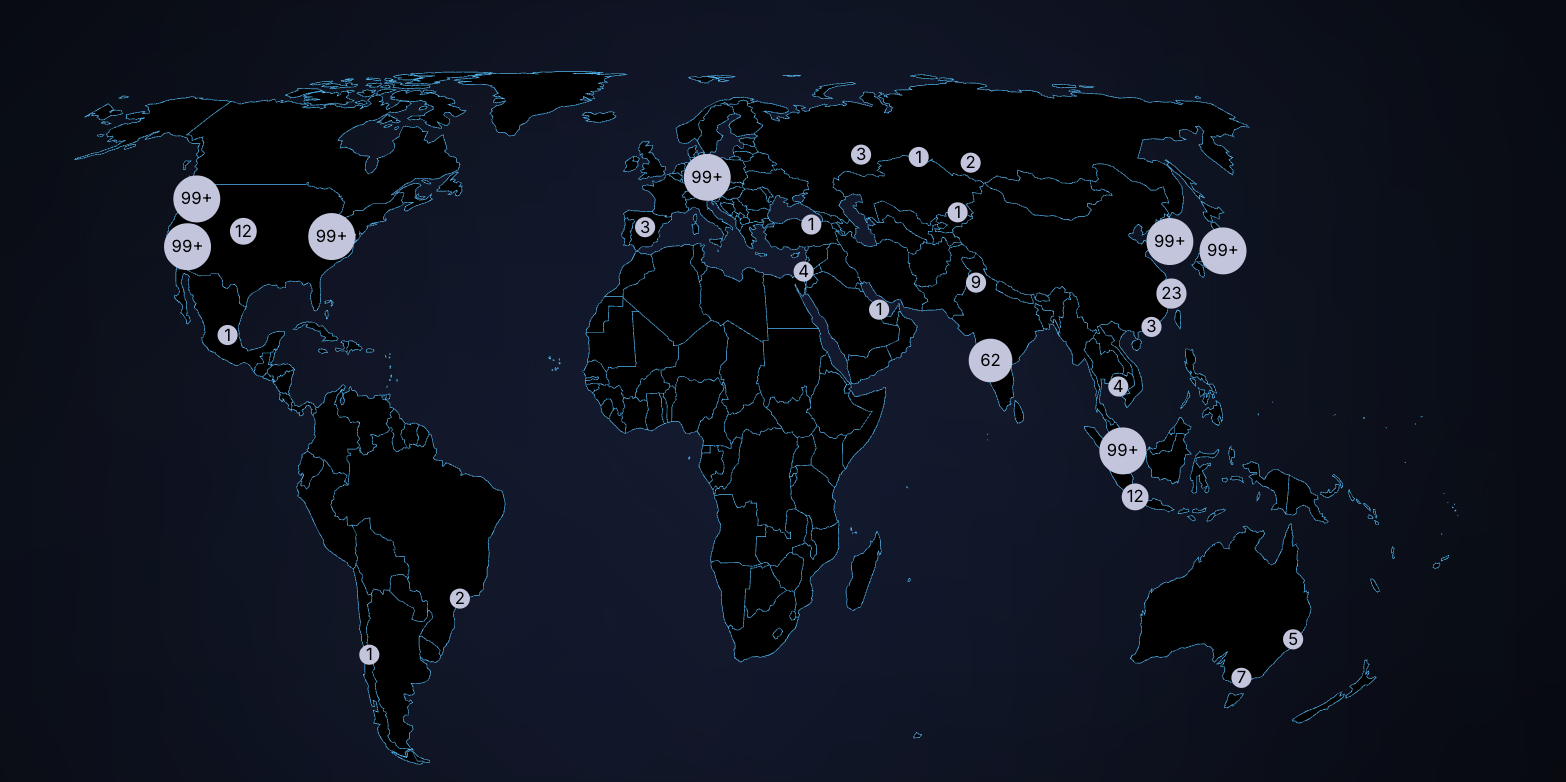
We're now entering a new phase: the Adversarial Testnet. This stage will test the resilience of the Aztec Testnet and its decentralization mechanisms.
The Adversarial Testnet introduces two key features: slashing, which penalizes validators for malicious or negligent behavior in Proof-of-Stake (PoS) networks, and a fully decentralized governance mechanism for protocol upgrades.
This phase will also simulate network attacks to test its ability to recover independently, ensuring it could continue to operate even if the core team and servers disappeared (see more on Vitalik’s “walkaway test” here). It also opens the validator set to more people using ZKPassport, a private identity verification app, to verify their identity online.
The Aztec Network testnet is decentralized, run by a permissionless network of sequencers.
The slashing upgrade tests one of the most fundamental mechanisms for removing inactive or malicious sequencers from the validator set, an essential step toward strengthening decentralization.
Similar to Ethereum, on the Aztec Network, any inactive or malicious sequencers will be slashed and removed from the validator set. Sequencers will be able to slash any validator that makes no attestations for an entire epoch or proposes an invalid block.
Three slashes will result in being removed from the validator set. Sequencers may rejoin the validator set at any time after getting slashed; they just need to rejoin the queue.
In addition to testing network resilience when validators go offline and evaluating the slashing mechanisms, the Adversarial Testnet will also assess the robustness of the network’s decentralized governance during protocol upgrades.
Adversarial Testnet introduces changes to Aztec Network’s governance system.
Sequencers now have an even more central role, as they are the sole actors permitted to deposit assets into the Governance contract.
After the upgrade is defined and the proposed contracts are deployed, sequencers will vote on and implement the upgrade independently, without any involvement from Aztec Labs and/or the Aztec Foundation.
Starting today, you can join the Adversarial Testnet to help battle-test Aztec’s decentralization and security. Anyone can compete in six categories for a chance to win exclusive Aztec swag, be featured on the Aztec X account, and earn a DappNode. The six challenge categories include:
Performance will be tracked using Dashtec, a community-built dashboard that pulls data from publicly available sources. Dashtec displays a weighted score of your validator performance, which may be used to evaluate challenges and award prizes.
The dashboard offers detailed insights into sequencer performance through a stunning UI, allowing users to see exactly who is in the current validator set and providing a block-by-block view of every action taken by sequencers.
To join the validator set and start tracking your performance, click here. Join us on Thursday, July 31, 2025, at 4 pm CET on Discord for a Town Hall to hear more about the challenges and prizes. Who knows, we might even drop some alpha.
To stay up-to-date on all things Noir and Aztec, make sure you’re following along on X.
Privacy has emerged as a major driver for the crypto industry in 2025. We’ve seen the explosion of Zcash, the Ethereum Foundation’s refocusing of PSE, and the launch of Aztec’s testnet with over 24,000 validators powering the network. Many apps have also emerged to bring private transactions to Ethereum and Solana in various ways, and exciting technologies like ZKPassport that privately bring identity on-chain using Noir have become some of the most talked about developments for ushering in the next big movements to the space.
Underpinning all of these developments is the emerging consensus that without privacy, blockchains will struggle to gain real-world adoption.
Without privacy, institutions can’t bring assets on-chain in a compliant way or conduct complex swaps and trades without revealing their strategies. Without privacy, DeFi remains dominated and controlled by advanced traders who can see all upcoming transactions and manipulate the market. Without privacy, regular people will not want to move their lives on-chain for the entire world to see every detail about their every move.
While there's been lots of talk about privacy, few can define it. In this piece we’ll outline the three pillars of privacy and gives you a framework for evaluating the privacy claims of any project.
True privacy rests on three essential pillars: transaction privacy, identity privacy, and computational privacy. It is only when we have all three pillars that we see the emergence of a private world computer.

Transaction privacy means that both inputs and outputs are not viewable by anyone other than the intended participants. Inputs include any asset, value, message, or function calldata that is being sent. Outputs include any state changes or transaction effects, or any transaction metadata caused by the transaction. Transaction privacy is often primarily achieved using a UTXO model (like Zcash or Aztec’s private state tree). If a project has only the option for this pillar, it can be said to be confidential, but not private.
Identity privacy means that the identities of those involved are not viewable by anyone other than the intended participants. This includes addresses or accounts and any information about the identity of the participants, such as tx.origin, msg.sender, or linking one’s private account to public accounts. Identity privacy can be achieved in several ways, including client-side proof generation that keeps all user info on the users’ devices. If a project has only the option for this pillar, it can be said to be anonymous, but not private.
Computation privacy means that any activity that happens is not viewable by anyone other than the intended participants. This includes the contract code itself, function execution, contract address, and full callstack privacy. Additionally, any metadata generated by the transaction is able to be appropriately obfuscated (such as transaction effects, events are appropriately padded, inclusion block number are in appropriate sets). Callstack privacy includes which contracts you call, what functions in those contracts you’ve called, what the results of those functions were, any subsequent functions that will be called after, and what the inputs to the function were. A project must have the option for this pillar to do anything privately other than basic transactions.
Bitcoin ushered in a new paradigm of digital money. As a permissionless, peer-to-peer currency and store of value, it changed the way value could be sent around the world and who could participate. Ethereum expanded this vision to bring us the world computer, a decentralized, general-purpose blockchain with programmable smart contracts.

Given the limitations of running a transparent blockchain that exposes all user activity, accounts, and assets, it was clear that adding the option to preserve privacy would unlock many benefits (and more closely resemble real cash). But this was a very challenging problem. Zcash was one of the first to extend Bitcoin’s functionality with optional privacy, unlocking a new privacy-preserving UTXO model for transacting privately. As we’ll see below, many of the current privacy-focused projects are working on similar kinds of private digital money for Ethereum or other chains.
Now, Aztec is bringing us the final missing piece: a private world computer.
A private world computer is fully decentralized, programmable, and permissionless like Ethereum and has optional privacy at every level. In other words, Aztec is extending all the functionality of Ethereum with optional transaction, identity, and computational privacy. This is the only approach that enables fully compliant, decentralized applications to be built that preserve user privacy, a new design space that we see as ushering in the next Renaissance for the space.
Private digital money emerges when you have the first two privacy pillars covered - transactions and identity - but you don’t have the third - computation. Almost all projects today that claim some level of privacy are working on private digital money. This includes everything from privacy pools on Ethereum and L2s to newly emerging payment L1s like Tempo and Arc that are developing various degrees of transaction privacy
When it comes to digital money, privacy exists on a spectrum. If your identity is hidden but your transactions are visible, that's what we call anonymous. If your transactions are hidden but your identity is known, that's confidential. And when both your identity and transactions are protected, that's true privacy. Projects are working on many different approaches to implement this, from PSE to Payy using Noir, the zkDSL built to make it intuitive to build zk applications using familiar Rust-like syntax.

Private digital money is designed to make payments private, but any interaction with more complex smart contracts than a straightforward payment transaction is fully exposed.
What if we also want to build decentralized private apps using smart contracts (usually multiple that talk to each other)? For this, you need all three privacy pillars: transaction, identity, and compute.
If you have these three pillars covered and you have decentralization, you have built a private world computer. Without decentralization, you are vulnerable to censorship, privileged backdoors and inevitable centralized control that can compromise privacy guarantees.

What exactly is a private world computer? A private world computer extends all the functionality of Ethereum with optional privacy at every level, so developers can easily control which aspects they want public or private and users can selectively disclose information. With Aztec, developers can build apps with optional transaction, identity, and compute privacy on a fully decentralized network. Below, we’ll break down the main components of a private world computer.

A private world computer is powered by private smart contracts. Private smart contracts have fully optional privacy and also enable seamless public and private function interaction.
Private smart contracts simply extend the functionality of regular smart contracts with added privacy.
As a developer, you can easily designate which functions you want to keep private and which you want to make public. For example, a voting app might allow users to privately cast votes and publicly display the result. Private smart contracts can also interact privately with other smart contracts, without needing to make it public which contracts have interacted.
Transaction: Aztec supports the optionality for fully private inputs, including messages, state, and function calldata. Private state is updated via a private UTXO state tree.
Identity: Using client-side proofs and function execution, Aztec can optionally keep all user info private, including tx.origin and msg.sender for transactions.
Computation: The contract code itself, function execution, and call stack can all be kept private. This includes which contracts you call, what functions in those contracts you’ve called, what the results of those functions were, and what the inputs to the function were.
A decentralized network must be made up of a permissionless network of operators who run the network and decide on upgrades. Aztec is run by a decentralized network of node operators who propose and attest to transactions. Rollup proofs on Aztec are also run by a decentralized prover network that can permissionlessly submit proofs and participate in block rewards. Finally, the Aztec network is governed by the sequencers, who propose, signal, vote, and execute network upgrades.
A private world computer enables the creation of DeFi applications where accounts, transactions, order books, and swaps remain private. Users can protect their trading strategies and positions from public view, preventing front-running and maintaining competitive advantages. Additionally, users can bridge privately into cross-chain DeFi applications, allowing them to participate in DeFi across multiple blockchains while keeping their identity private despite being on an existing transparent blockchain.
This technology makes it possible to bring institutional trading activity on-chain while maintaining the privacy that traditional finance requires. Institutions can privately trade with other institutions globally, without having to touch public markets, enjoying the benefits of blockchain technology such as fast settlement and reduced counterparty risk, without exposing their trading intentions or volumes to the broader market.
Organizations can bring client accounts and assets on-chain while maintaining full compliance. This infrastructure protects on-chain asset trading and settlement strategies, ensuring that sophisticated financial operations remain private. A private world computer also supports private stablecoin issuance and redemption, allowing financial institutions to manage digital currency operations without revealing sensitive business information.
Users have granular control over their privacy settings, allowing them to fine-tune privacy levels for their on-chain identity according to their specific needs. The system enables selective disclosure of on-chain activity, meaning users can choose to reveal certain transactions or holdings to regulators, auditors, or business partners while keeping other information private, meeting compliance requirements.
The shift from transparent blockchains to privacy-preserving infrastructure is the foundation for bringing the next billion users on-chain. Whether you're a developer building the future of private DeFi, an institution exploring compliant on-chain solutions, or simply someone who believes privacy is a fundamental right, now is the time to get involved.
Follow Aztec on X to stay updated on the latest developments in private smart contracts and decentralized privacy technology. Ready to contribute to the network? Run a node and help power the private world computer.
The next Renaissance is here, and it’s being powered by the private world computer.
After eight years of solving impossible problems, the next renaissance is here.
We’re at a major inflection point, with both our tech and our builder community going through growth spurts. The purpose of this rebrand is simple: to draw attention to our full-stack privacy-native network and to elevate the rich community of builders who are creating a thriving ecosystem around it.
For eight years, we’ve been obsessed with solving impossible challenges. We invented new cryptography (Plonk), created an intuitive programming language (Noir), and built the first decentralized network on Ethereum where privacy is native rather than an afterthought.
It wasn't easy. But now, we're finally bringing that powerful network to life. Testnet is live with thousands of active users and projects that were technically impossible before Aztec.
Our community evolution mirrors our technical progress. What started as an intentionally small, highly engaged group of cracked developers is now welcoming waves of developers eager to build applications that mainstream users actually want and need.
A brand is more than aesthetics—it's a mental model that makes Aztec's spirit tangible.
Renaissance means "rebirth"—and that's exactly what happens when developers gain access to privacy-first infrastructure. We're witnessing the emergence of entirely new application categories, business models, and user experiences.
The faces of this renaissance are the builders we serve: the entrepreneurs building privacy-preserving DeFi, the activists building identity systems that protect user privacy, the enterprise architects tokenizing real-world assets, and the game developers creating experiences with hidden information.
This next renaissance isn't just about technology—it's about the ethos behind the build. These aren't just our values. They're the shared DNA of every builder pushing the boundaries of what's possible on Aztec.
Agency: It’s what everyone deserves, and very few truly have: the ability to choose and take action for ourselves. On the Aztec Network, agency is native
Genius: That rare cocktail of existential thirst, extraordinary brilliance, and mind-bending creation. It’s fire that fuels our great leaps forward.
Integrity: It’s the respect and compassion we show each other. Our commitment to attacking the hardest problems first, and the excellence we demand of any solution.
Obsession: That highly concentrated insanity, extreme doggedness, and insatiable devotion that makes us tick. We believe in a different future—and we can make it happen, together.
Just as our technology bridges different eras of cryptographic innovation, our new visual identity draws from multiple periods of human creativity and technological advancement.
Our new wordmark embodies the diversity of our community and the permissionless nature of our network. Each letter was custom-drawn to reflect different pivotal moments in human communication and technological progress.
Together, these letters tell the story of human innovation: each era building on the last, each breakthrough enabling the next renaissance. And now, we're building the infrastructure for the one that's coming.
We evolved our original icon to reflect this new chapter while honoring our foundation. The layered diamond structure tells the story:
The architecture echoes a central plaza—the Roman forum, the Greek agora, the English commons, the American town square—places where people gather, exchange ideas, build relationships, and shape culture. It's a fitting symbol for the infrastructure enabling the next leap in human coordination and creativity.
From the Mughal and Edo periods to the Flemish and Italian Renaissance, our brand imagery draws from different cultures and eras of extraordinary human flourishing—periods when science, commerce, culture and technology converged to create unprecedented leaps forward. These visuals reflect both the universal nature of the Renaissance and the global reach of our network.
But we're not just celebrating the past —we're creating the future: the infrastructure for humanity's next great creative and technological awakening, powered by privacy-native blockchain technology.
Join us to ask questions, learn more and dive into the lore.
Join Our Discord Town Hall. September 4th at 8 AM PT, then every Thursday at 7 AM PT. Come hear directly from our team, ask questions, and connect with other builders who are shaping the future of privacy-first applications.
Take your stance on privacy. Visit the privacy glyph generator to create your custom profile pic and build this new world with us.
Stay Connected. Visit the new website and to stay up-to-date on all things Noir and Aztec, make sure you’re following along on X.
The next renaissance is what you build on Aztec—and we can't wait to see what you'll create.
Aztec’s Public Testnet launched in May 2025.
Since then, we’ve been obsessively working toward our ultimate goal: launching the first fully decentralized privacy-preserving layer-2 (L2) network on Ethereum. This effort has involved a team of over 70 people, including world-renowned cryptographers and builders, with extensive collaboration from the Aztec community.
To make something private is one thing, but to also make it decentralized is another. Privacy is only half of the story. Every component of the Aztec Network will be decentralized from day one because decentralization is the foundation that allows privacy to be enforced by code, not by trust. This includes sequencers, which order and validate transactions, provers, which create privacy-preserving cryptographic proofs, and settlement on Ethereum, which finalizes transactions on the secure Ethereum mainnet to ensure trust and immutability.
Strong progress is being made by the community toward full decentralization. The Aztec Network now includes nearly 1,000 sequencers in its validator set, with 15,000 nodes spread across more than 50 countries on six continents. With this globally distributed network in place, the Aztec Network is ready for users to stress test and challenge its resilience.

We're now entering a new phase: the Adversarial Testnet. This stage will test the resilience of the Aztec Testnet and its decentralization mechanisms.
The Adversarial Testnet introduces two key features: slashing, which penalizes validators for malicious or negligent behavior in Proof-of-Stake (PoS) networks, and a fully decentralized governance mechanism for protocol upgrades.
This phase will also simulate network attacks to test its ability to recover independently, ensuring it could continue to operate even if the core team and servers disappeared (see more on Vitalik’s “walkaway test” here). It also opens the validator set to more people using ZKPassport, a private identity verification app, to verify their identity online.
The Aztec Network testnet is decentralized, run by a permissionless network of sequencers.
The slashing upgrade tests one of the most fundamental mechanisms for removing inactive or malicious sequencers from the validator set, an essential step toward strengthening decentralization.
Similar to Ethereum, on the Aztec Network, any inactive or malicious sequencers will be slashed and removed from the validator set. Sequencers will be able to slash any validator that makes no attestations for an entire epoch or proposes an invalid block.
Three slashes will result in being removed from the validator set. Sequencers may rejoin the validator set at any time after getting slashed; they just need to rejoin the queue.
In addition to testing network resilience when validators go offline and evaluating the slashing mechanisms, the Adversarial Testnet will also assess the robustness of the network’s decentralized governance during protocol upgrades.
Adversarial Testnet introduces changes to Aztec Network’s governance system.
Sequencers now have an even more central role, as they are the sole actors permitted to deposit assets into the Governance contract.
After the upgrade is defined and the proposed contracts are deployed, sequencers will vote on and implement the upgrade independently, without any involvement from Aztec Labs and/or the Aztec Foundation.
Starting today, you can join the Adversarial Testnet to help battle-test Aztec’s decentralization and security. Anyone can compete in six categories for a chance to win exclusive Aztec swag, be featured on the Aztec X account, and earn a DappNode. The six challenge categories include:
Performance will be tracked using Dashtec, a community-built dashboard that pulls data from publicly available sources. Dashtec displays a weighted score of your validator performance, which may be used to evaluate challenges and award prizes.
The dashboard offers detailed insights into sequencer performance through a stunning UI, allowing users to see exactly who is in the current validator set and providing a block-by-block view of every action taken by sequencers.
To join the validator set and start tracking your performance, click here. Join us on Thursday, July 31, 2025, at 4 pm CET on Discord for a Town Hall to hear more about the challenges and prizes. Who knows, we might even drop some alpha.
To stay up-to-date on all things Noir and Aztec, make sure you’re following along on X.
On May 1st, 2025, Aztec Public Testnet went live.
Within the first 24 hours, over 20k users visited the Aztec Playground and started to send transactions on testnet. Additionally, 10 apps launched live on the testnet, including wallets, block explorers, and private DeFi and NFT marketplaces. Launching a decentralized testnet poses significant challenges, and we’re proud that the network has continued to run despite high levels of congestion that led to slow block production for a period of time.
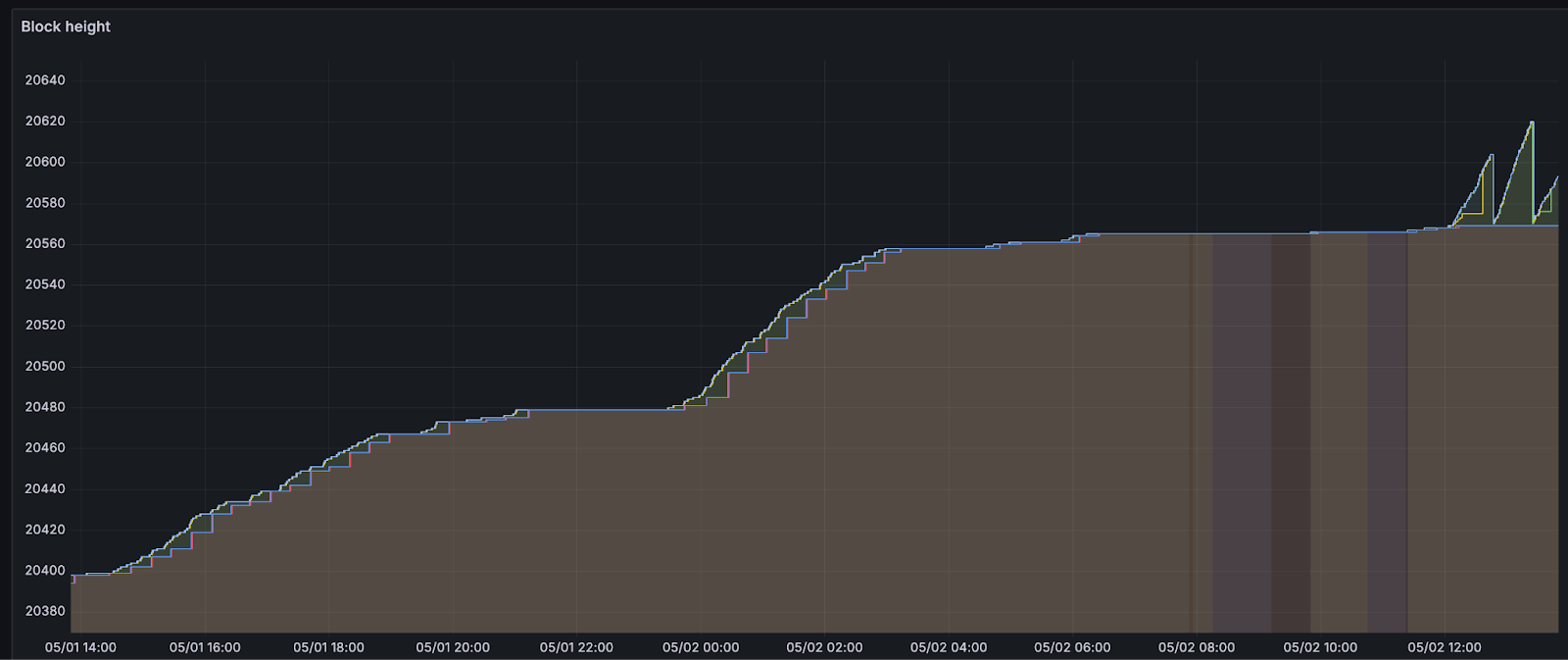
Around 6 hours after announcing the network launch, more than 150 sequencers had joined the validator set to sequence transactions and propose blocks for the network. 500+ additional full nodes were spun up by node operators participating in our Discord community. These sequencers were flooded with over 5k transactions before block production slowed. Let’s dive into why block production slowed down.
On Aztec, an epoch is a group of 32 blocks that are rolled up for settlement on Ethereum. Leading up to the slowdown of block production, there were entire epochs with full blocks (8 transactions, or 0.2TPS) in every slot. The sequencers were building blocks and absorbing the demand for blockspace from users of the Aztec playground, and there was a build up of 100s of pending transactions in sequencer mempools.
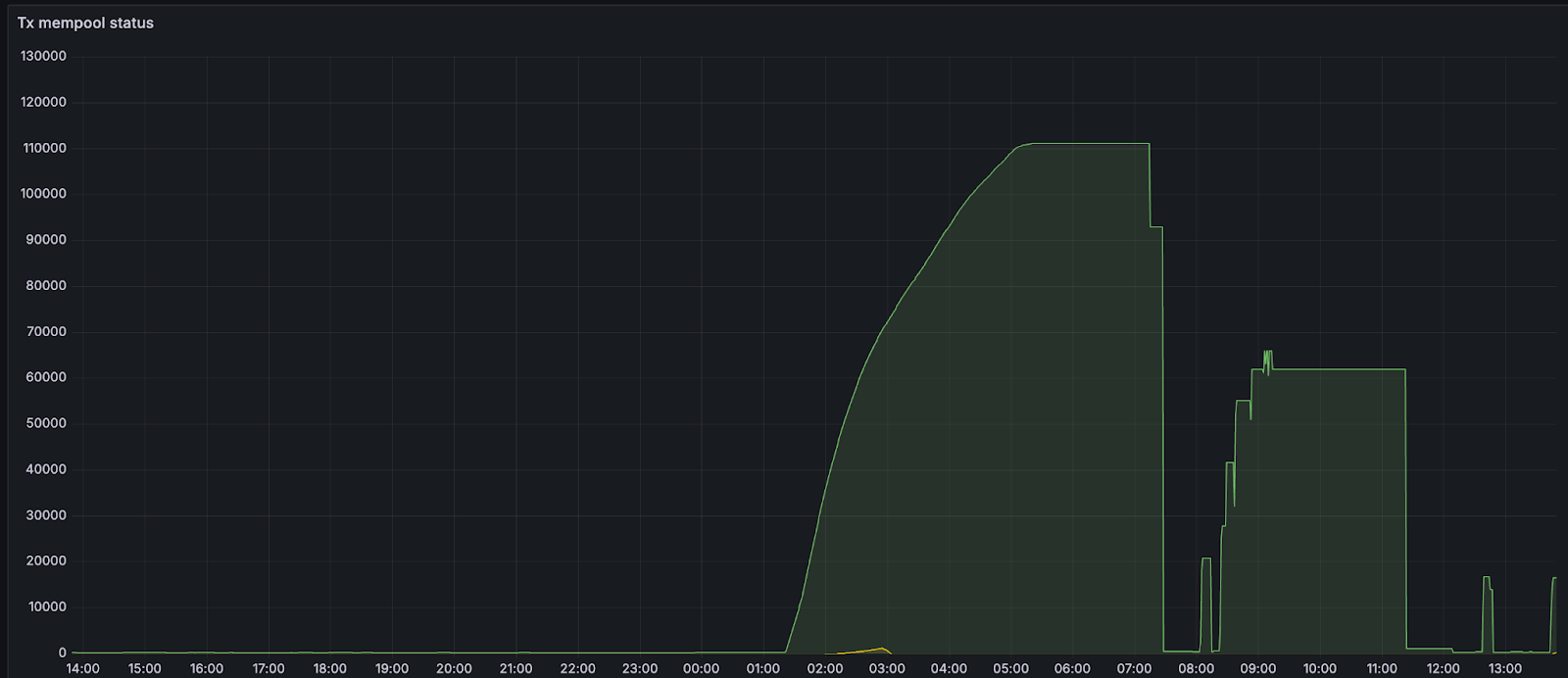
Issues arose when these transactions started to exceed the mempool size, which was configured to hold only 100mb or about 700 transactions.
As many new validators were brought through the funnel and started to come online, the mempools of existing validators (already full at 700 transactions) and new ones (at 0 transactions) diverged significantly. When earlier validators proposed blocks, newer validators didn't have the transactions and could not attest to blocks because the request/response protocol wasn't aggressive enough. When newer validators made proposals, earlier validators didn't have transactions (their mempools were full), so they could not attest to blocks.
New validators then started to build up pending transactions. When validators with full mempools requested missing transactions from peers, they would evict existing transactions from their mempools (mempool is at max memory) based on priority fee. All transactions had default fee settings, so validators were randomly ejecting transactions and were not doing so in lockstep (different validators ejected different transactions). For a little over an hour, the mempools diverged significantly from each other, and block production slowed down to about 20% of the expected rate.
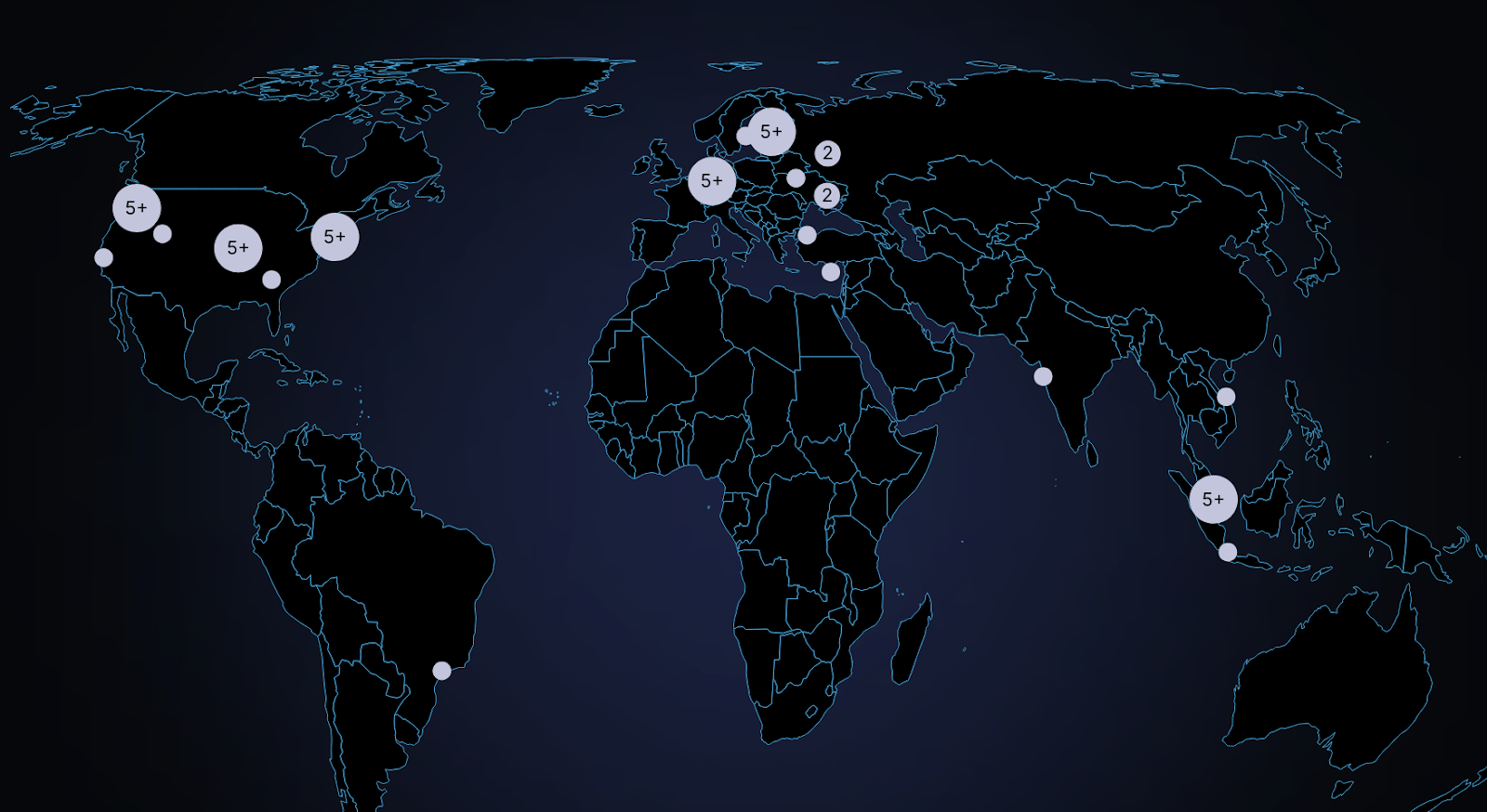
In order to stop the mempool from ejecting transactions, the p2p mempool size was increased. By increasing the mempool size, the likelihood of needing to evict transactions that might soon appear in proposals is reduced. This increases the chances that sequencers already have the necessary transactions locally when they receive a block proposal. As a result, more validators are able to attest to proposals, allowing blocks to be finalized more reliably. Once blocks are included on L1, their transactions are evicted from the mempool. So over time, as more blocks are finalized and transactions are mined, the mempool naturally shrinks and the network will recover on its own.
If you are interested in running a sequencer node visit the sequencer page. Stay up-to-date on Noir and Aztec by following Noir and Aztec on X.
Ariel Gabizon, a distinguished cryptographer, coauthor of PLONK, and pioneer of zero-knowledge (ZK) technology, has rejoined Aztec Labs as its Chief Scientist.
Ariel brings over 14 years of experience in mathematics and has played a key role in major advancements in ZK technology. He began with a PhD in Theoretical Computer Science from the Weizmann Institute. During his postdoctoral tenure, a serendipitous encounter with the Bitcoin whitepaper ignited his passion for applied cryptography.
This led him to join Eli Ben-Sasson's lab, where he made significant contributions to the early development of STARKs when they were known as probabilistically checkable proofs (PCPs). He was involved in the first deployment of ZK technology at Zcash and coauthored two pivotal papers that made SNARK setups practical and viable.
In addition to his groundbreaking work on the PLONK paper, co-authored with Zachary Williamson, Ariel also helped discover a crucial counterfeiting vulnerability stemming from the underlying zk-SNARK originally used by Zcash. Since then, he has been advancing the state of the art in polynomial commitment schemes (SHPLONK, FFLONK), lookup protocols (Plookup,cq) and folding schemes (ProtoGalaxy).
With Devnet now live and private, client-side smart contract execution with public verifiability possible, Ariel is rejoining us at a pivotal moment for Aztec, our upcoming privacy-first L2 on Ethereum. His expertise and vision will be vital in continuing to drive our efforts to build a more private, secure, and efficient blockchain ecosystem. As Chief Scientist, Ariel will spearhead our research and development efforts, focusing on enhancing the privacy and scalability of Aztec. Ariel’s expertise will not only bolster our existing work but pave the way for innovative advancements in ZK technology. You can read more about the work Ariel is doing at Aztec via his recently published paper, Private Proofs of Stack and Contract Execution Using Protogalaxy.
Ariel is speaking at the Verifiable Summit during Warsaw Blockchain Week on September 4th, 2024. This event will provide a platform for Ariel to discuss recent progress on Fast Fourier Transforms from the Galois FFT and circle STARK papers. Get your discounted ticket using FRENSOFAZTEC.
We are confident that Ariel’s experience and expertise in mathematics, cryptography and ZK technology will propel us to new heights. We invite our community to follow us on X for regular updates.
Devnet is now live! This milestone enables private, client-side smart contract execution with robust public verifiability, a massive milestone for Aztec and the Ethereum community.
To celebrate this milestone, we’re launching Alpha Build, a series of three developer sprints with a USD $100,000 prize pool and the opportunity to deploy on the Aztec Network for the first time.
The first Alpha Build will kick off Monday, August 19th with two additional Alpha Builds happening by mid-November. Alpha Build participants will receive expert mentorship, gain direct access to the team, and connect with a growing community of over 300 developers from around the globe. In addition to cash prizes, top builders will be invited to deploy their applications on the Devnet.
Complete the Alpha Build Application to gain access to the Discord server, and download the Aztec Sandbox to get started.
Devnet is a culmination of all the hard work and iteration over the past 7 years.
In March 2023, we made a bold commitment to focus on bringing the Aztec Network to life and delivering true programmable privacy. Over the past year and a half, our team has worked tirelessly to bring this vision to life, and their efforts have paid off.
Today, we’re proud to deliver on that commitment and unveil a live Devnet, realizing the integration of all essential components of the tech stack, including Honk, cutting-edge cryptography, Noir for smart contract development, a private execution environment (PXE) for client-side proof generation, and a sequencer for transaction processing and public execution.
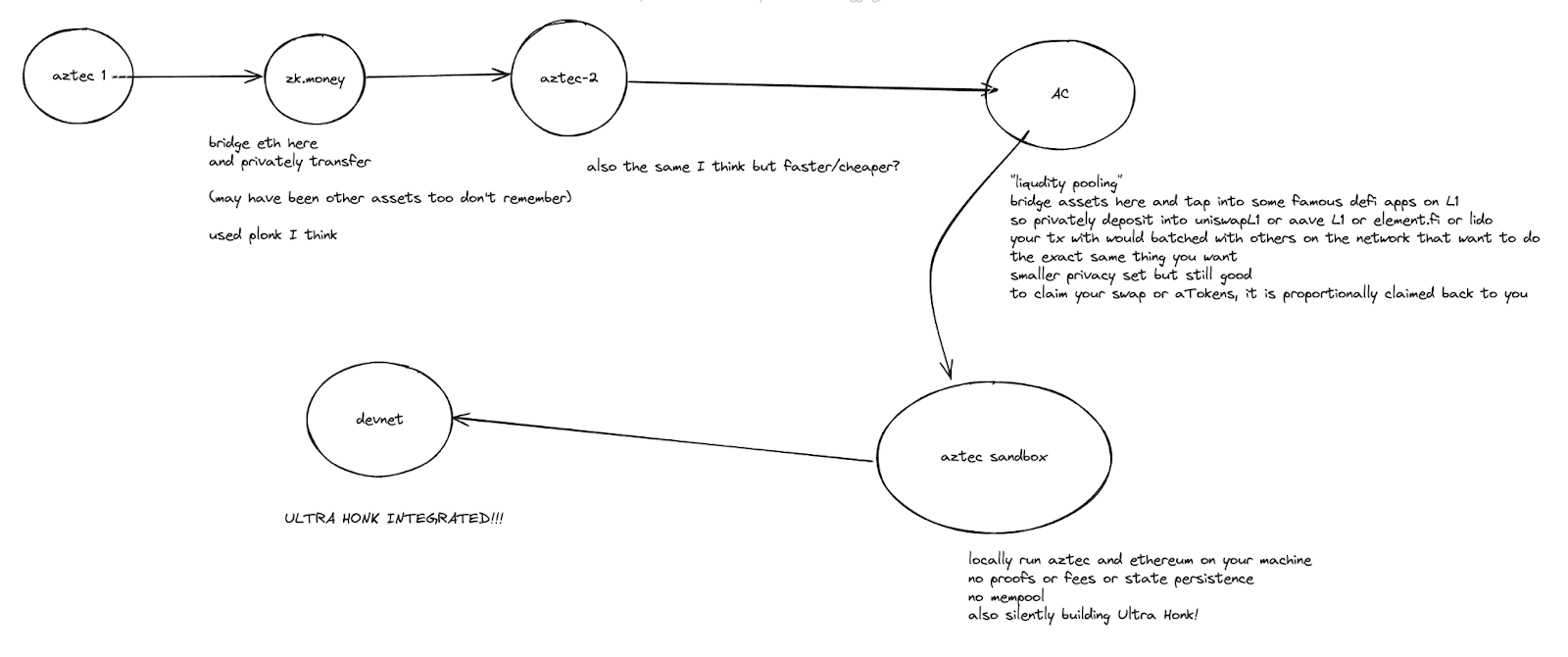
Together, they enable private, client-side smart contract execution with robust public verifiability, marking a significant leap forward for the Aztec Network.
Over the next few months, we’ll run three themed Alpha Builds with challenges across the most important use cases in crypto, including payments, gaming, and identity. Privacy expands the design space so you can explore solutions for conditional payments, on and off-chain access control using NFTs stored privately on Aztec, or card games with a shared hidden public state.
The three challenges for Alpha Build One (ab1) will focus on payment use cases with an emphasis on building a UI, Account Abstraction and Fee Abstraction features. If you’re new to Aztec or have been with us from the beginning, ab1 is your chance to dive deep into underexplored problems and designs while contributing to the growing ecosystem.
Complete the Alpha Build Application to gain access to the Discord server, and download the Aztec Sandbox to get started.
The Alpha Build payment challenges are designed to build upon each other, increasing in complexity as the weeks progress. Here’s what you can expect:
Throughout the challenges, the DevRel Team will provide Discord support and host weekly office hours from 10 a.m. - 11 a.m. ET every Wednesday and Thursday.
All submissions for ab1 are due by Sunday, September 15th, 2024, and must include the following:
Don’t miss this opportunity to deploy on the Aztec Network for the first time.
To get started, fill out the Alpha Build Application. We will review applications and, if selected, invite you to join a private Discord channel for our Alpha Build.
The Devnet Live Celebration will be on Friday, August 16th, 2024, at 11:30 a.m. ET on X. Join Cat, our Developer Relations Engineer, and President and Co-Founder, Joe Andrews as they dive deep into Alpha Build season, exploring challenges, themes, and innovative ideas.
In blockchain narrative, the term “zero knowledge” entered our vocabulary when rollups first emerged. In particular, we’ve heard it a lot in the context of zero knowledge rollups (ZK-rollups). But, zero knowledge technology has existed for years before. The first article on zero knowledge was published back in 1989.
In this blog, we’ll break it down to clarify what zero knowledge (ZK) is and what it ISN’T (the latter might actually be more interesting than the former). We’ll investigate if ZK-rollups have any ZK for real, and if not, why they get to use the term at all, and dive into the difference between ZK as a technology and ZK as a marketing term.

For those who need answers right away:
*by privacy we mean (i) user privacy (transaction sender and recipient), (ii) data privacy (payload of the transaction, e.g., the asset or value being transacted), and (iii) code privacy (the program logic).
Now let’s dive a bit deeper.
If we want to discuss ZK in a rollup context, we first need to understand zero knowledge property on its own. As we mentioned above, the concept of ZK was introduced in 1989 (years before the first blockchain was baked) in a paper titled, “The knowledge complexity of interactive proof systems.” It wasn’t until around 2018 that the Ethereum community figured out ZK might be a good fit for a rollup universe.
We usually consider zero knowledge as a property of a proving system. In blockchain, we often say ZKP, meaning zero knowledge proof. But “proof” might mean proof of statement or proof of knowledge. So, in the next section of this article, we will differentiate between the two types of proofs.
Proof of statement proves that a statement is true without revealing anything about the statement itself.
Examples of statements:
Proof of knowledge proves that the person making an assertion has some knowledge about the statement.
So, if we look at the examples from the previous paragraph side-by-side:
Proof of StatementProof of Knowledgez is a square modular n: z = x^2 mod n.I know a value x such that z = x^2 (mod n).The graphs G and H are non-isomorphic.I know the isomorphism between two graphs, G and H.The number 638634389........3427 has 3 prime factors.I know the factors of the number 638634389........3427.
One should note that every proof of knowledge is a proof of statement (but not the opposite). For instance, if one proves that they know a value x such that z = x^2 (mod n), this will be proof of knowledge, but it also automatically proves that z is a square modulo n (proof of statement).
Let’s explore one of these examples to see how proof of statement and proof of knowledge can be constructed!
Let’s use the graph-isomorphism problem. To do this, we’ll say proof of graph non-isomorphism will be proof of statement, while a proof of graph isomorphism will be proof of knowledge.
Basically graph isomorphism (denoted by ≅) is the following: two graphs with labeled nodes are isomorphic if they are "the same" up to a permutation of the labels. That is to say, there exists a permutation of the labels of one graph that results in the other graph.
More formally, we say that two graphs G and H are isomorphic if there is a bijective function f between the vertices’ labels of G and H such that there is an edge between the vertices u and v in G if and only if there is an edge between the vertices f(u) and f(v) in H.
An example of two isomorphic graphs:

If there exists no such permutation, we say that the two graphs are non-isomorphic. Now, assume we want to prove that two graphs are non-isomorphic. We only want to prove this single fact; nothing about the graphs themselves, no other knowledge except for the statement that they are non-isomorphic.
Proof intuition:
One round of protocol:
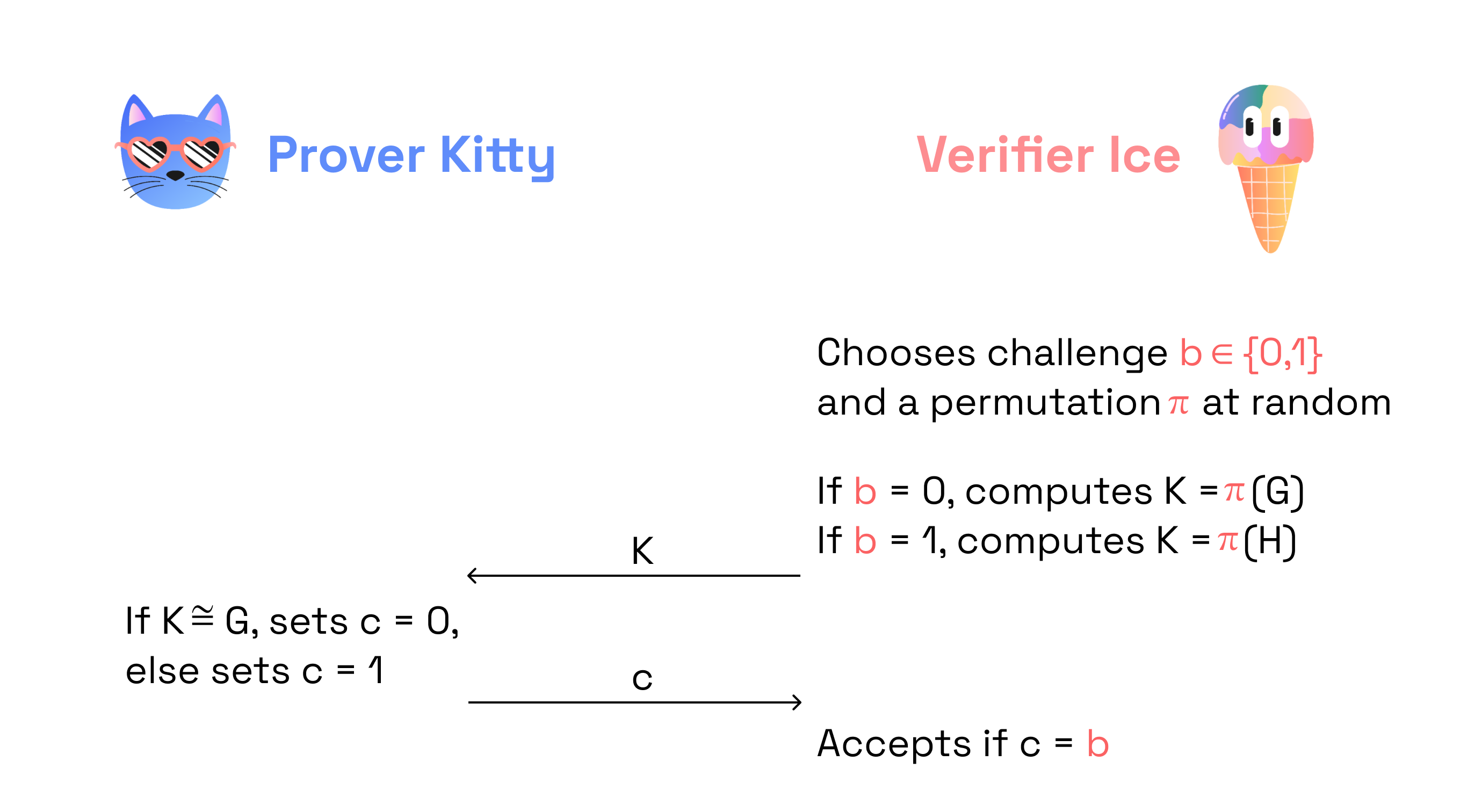
Now, let’s think… What if we want to prove two graphs are isomorphic? In other words, the Prover wants to prove that they know the isomorphism σ such that H = σ(G).
Proof intuition:

One round of protocol:
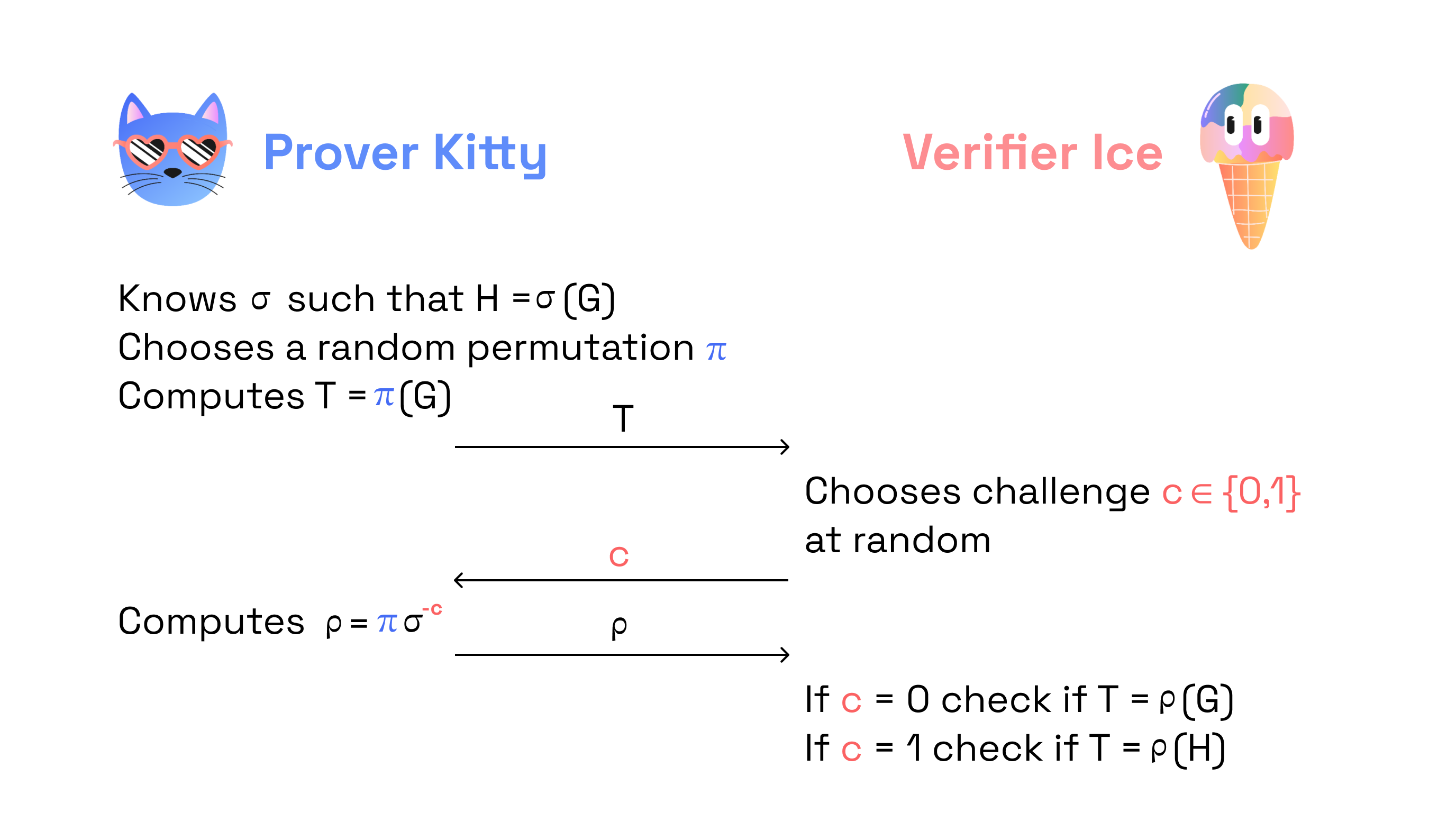
Now that we’ve explored examples of proof of statement and proof of knowledge, let’s discuss whether or not they have zero knowledge property.
Informally, zero knowledge means that a Verifier can’t retrieve any additional information from a Prover (except for the information clear from the proof itself).
In the example of graph isomorphism, proof of knowledge is zero knowledge (with honest Verifier). According to the protocol, the Prover doesn’t reveal any information on the isomorphism or permutation to the Verifier. Instead, they send the Verifier commitments and that’s it.
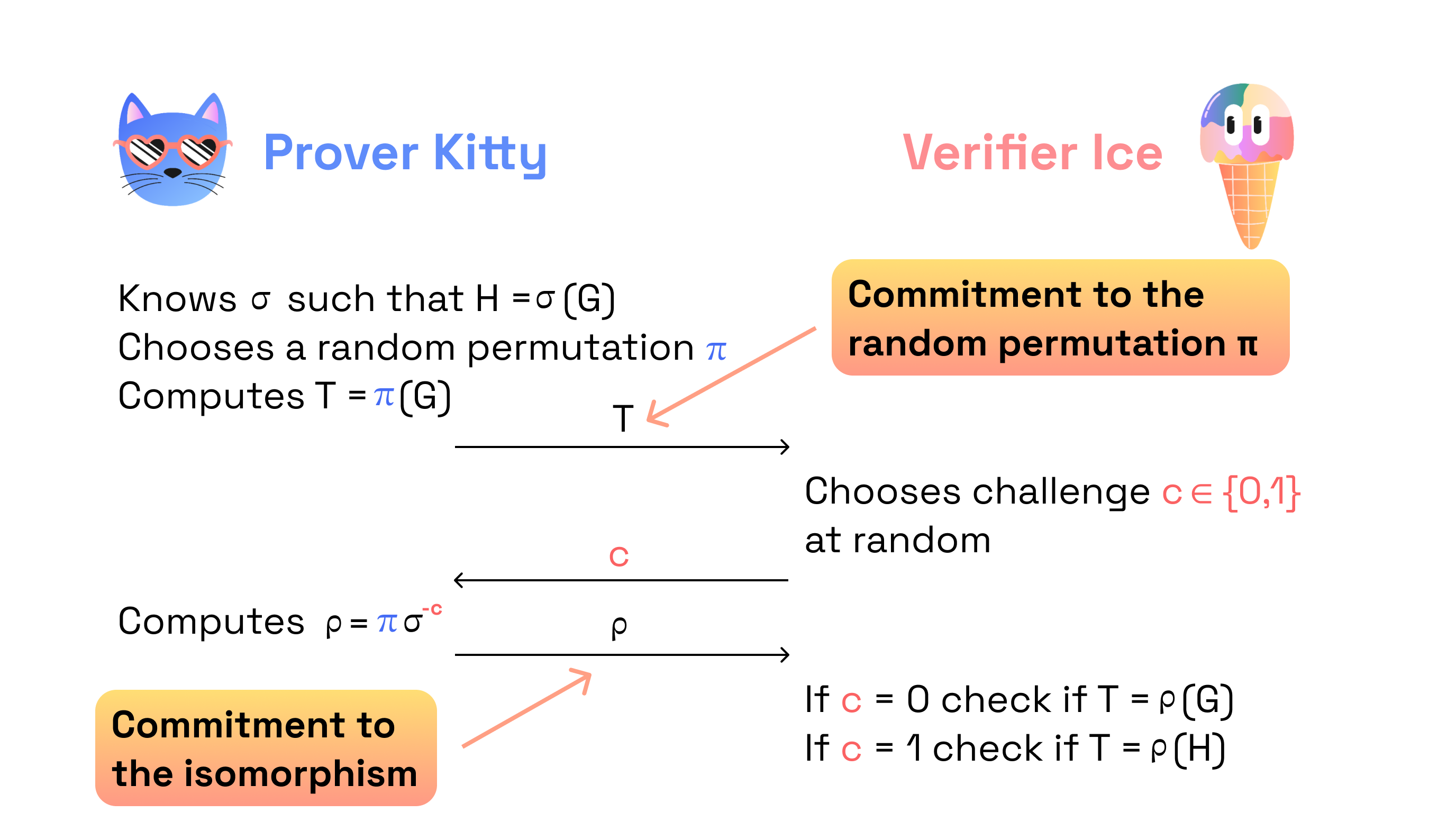
However, in the example of the proof of graph non-isomorphism, it’s not zero knowledge. Because, instead of setting K = π(G) or K = π(H), a malicious Verifier (i.e. a Verifier which deviates from the protocol) can set K = π{RANDOM GRAPH} and as a result of the protocol execution by the Prover, the Verifier will know if RANDOM_GRAPH is isomorphic to either G or H. So the Verifier is definitely able to retrieve additional information.

Can we convert our proof of graph non-isomorphism into zero knowledge? Yes, we can. The Verifier should also provide proof that (i) the graph it sends is isomorphic either to G or to H (meaning the graph they’re sending is not arbitrary), and (ii) they know the isomorphism.
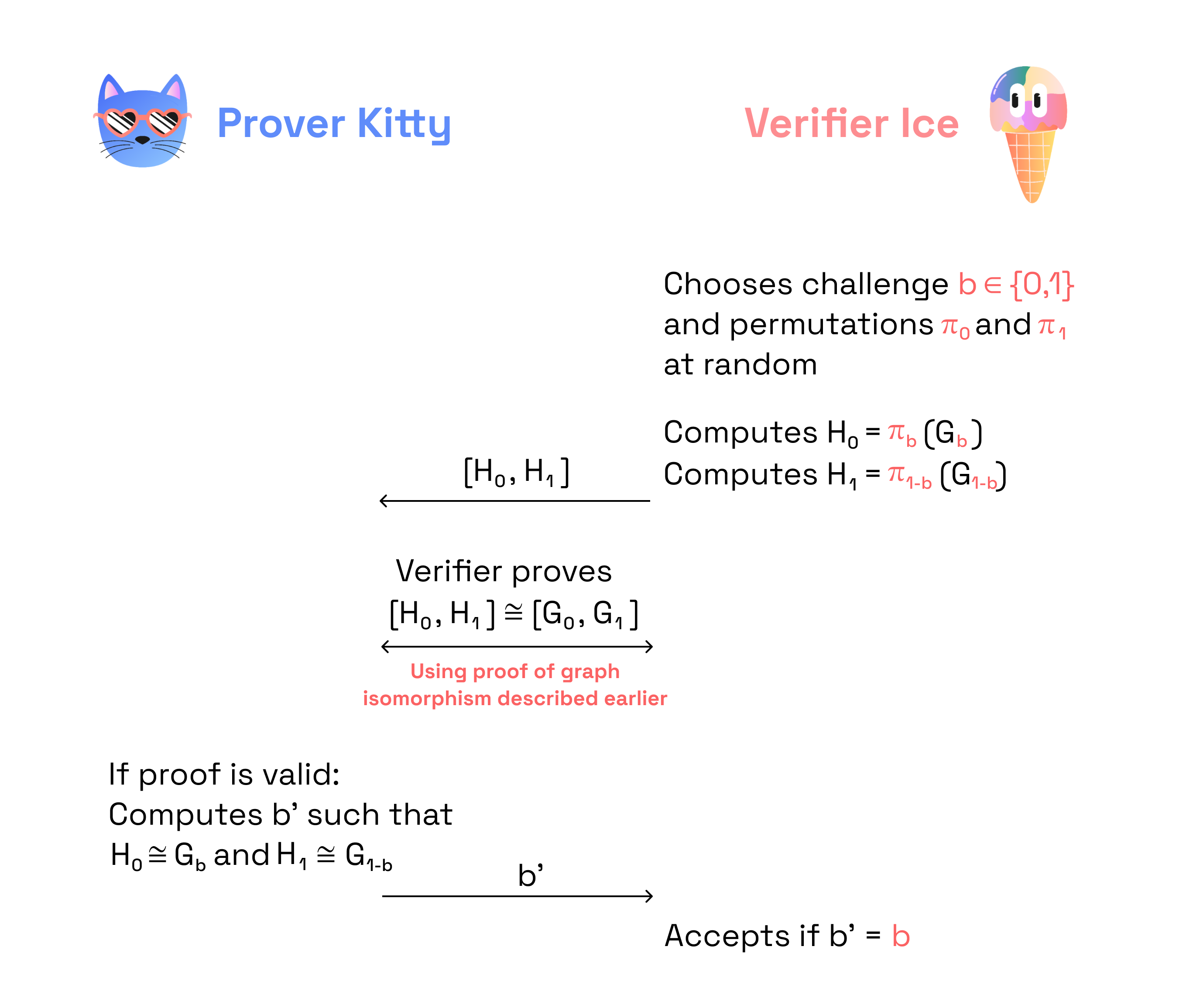
One should note that most protocols in the space are only honest-verifier ZK (i.e. ZK property doesn’t hold with malicious verifier). However, this isn’t an issue because the protocols are made non-interactive with the Fiat-Shamir heuristic. Hence – there is no distinction for non-interactive protocols as the verifier cannot "misbehave.”
Now, when we differentiated between proof of statement and proof of knowledge and saw that both of them can have zero knowledge property or not have it, let’s take a look at ZK-rollup and figure out (i) does it use proof of statement or proof of knowledge, (ii) does it have zero knowledge property?
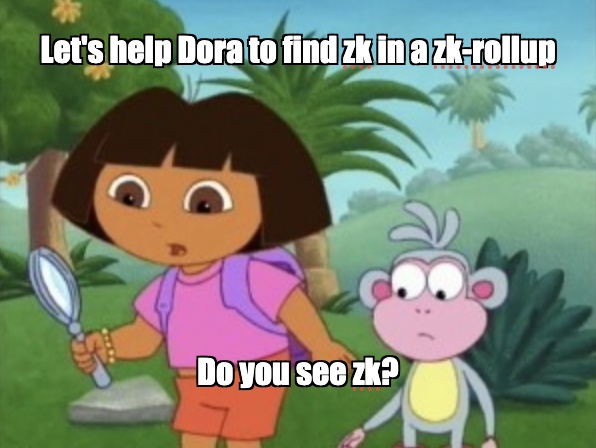
In a ZK-rollups, the logic is pretty similar to the graph-non-isomorphism problem (where we prove the statement that two graphs are non-isomorphic). In ZK-rollup, we prove the statement that the state transition was done correctly.
In this section, we’ll briefly cover how ZK-rollups work and how they utilize proofs. By “ZK-rollups,'' we mean regular (i.e. NON-privacy-preserving) ZK-rollups such as Scroll, Starknet, zksync, Taiko, and many more.
The main use of “vanilla” ZK-rollups is to enable scalability by posting a single proof of the validity of transactions.
ZK-rollups execute transactions off-chain and post proof on L1 (Ethereum) that whatever they did off-chain was done correctly. Their purpose is to prove that the new chain state is correct.
To generate a proof of correct state transition, one needs to prove that all transactions were executed correctly on given inputs.

For the sake of this, the Prover needs to know previous state and input values.
However, for the Verifier to verify the proof, they need to have the proof as well as to know new state, previous state, and input values:
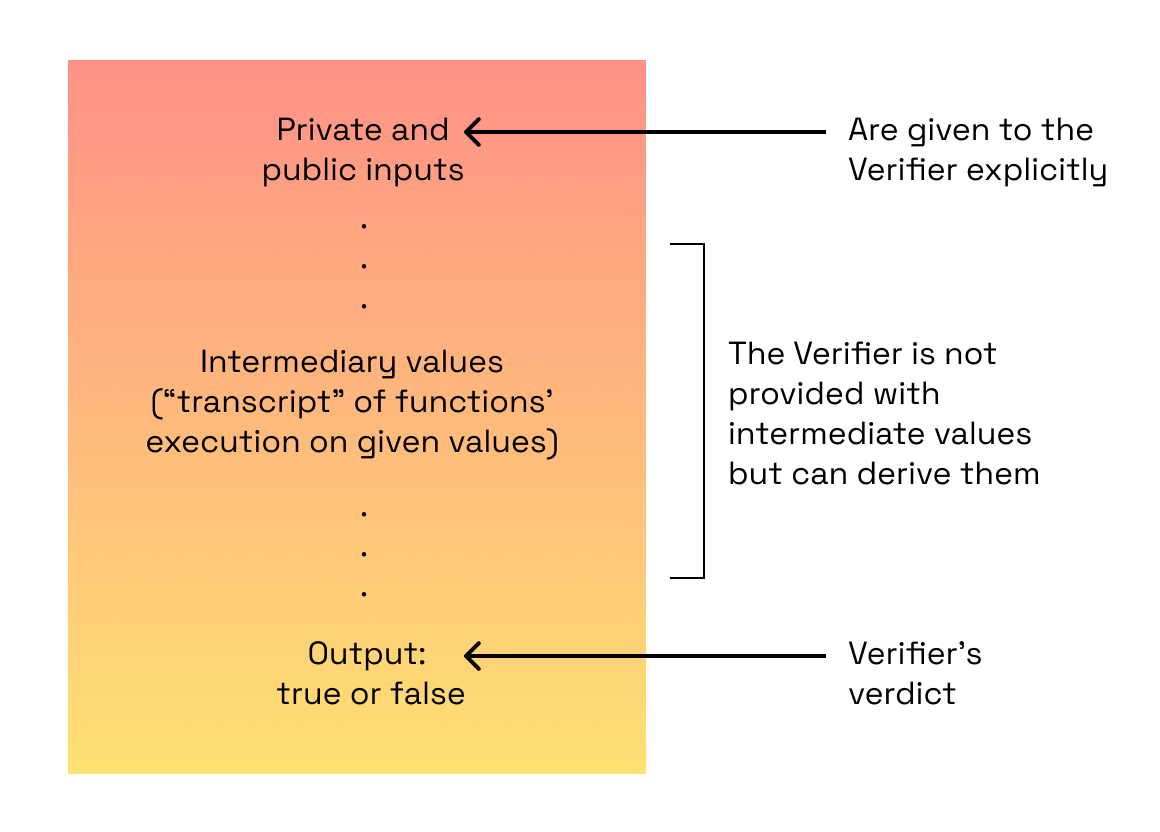
There are two types of inputs, public and private. In ZK-rollups, “private input” does NOT mean “secret” even though they are called “private.” Instead, it means that private inputs are consumed by Prover only while public inputs are consumed both by Prover and Verifier (sometimes private inputs are also called “witness” as a reference to the NP complexity class). Public inputs are expensive as they need to be submitted to L1 hence we want it to be as small (“succinct”) as possible. In terms of what these inputs consist of in the context of the proof:
Public inputs (consumed by Prover AND Verifier) – all data that needs to be submitted to L1 so that everyone can update their records of the current state. This will include new state root as well as might include signatures, sender, receiver, functions, contract addresses, function arguments, newly-deployed contract data, storage slots which have changed and their new values, events that were emitted. One should note that this reveals A LOT of information to a public observer. The specific list of public inputs will depend on the specific ZK-rollup design.
Private inputs (consumed by Prover ONLY) – all information that was needed by rollup circuits to prove correctness of the state transition. This will include Merkle membership proofs (hash paths) as well as the execution trace (might include transaction inputs such as newly-deployed contract data, storage slots which have changed and their new values, and events that were emitted).
As you can see from the logic above, private inputs have nothing to do with privacy. So if a ZK-rollup is generating a proof that Alice sent Bob 1ETH, both the Prover and the Verifier will be aware of this information (i.e. no privacy at all!).
To sum it up, in the case of a ZK-rollup, we want to prove the validity of transactions, it is a proof of statement and it does NOT have zero-knowledge property because all the information (i.e. state, functions, inputs) is public and everything that is not provided explicitly can be derived by a Verifier.
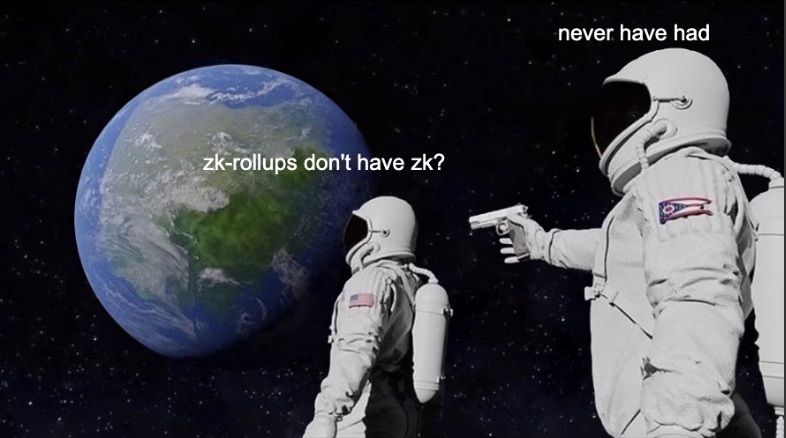
That is to say, there is no ZK in a vanilla ZK-rollup. Why is it called ZK-rollup then?
.png)
Maybe… For the sake of marketing =)
Short answer: yes, it can. While the main use of “vanilla” ZK-rollups is to enable scalability, the main use of Aztec is to enable scalability AND allow privacy. And, it utilizes ZK exactly for the privacy purpose.
Aztec provides privacy by means of client-side proof generation, i.e. whatever should be processed privately is processed on the user’s device and then a proof of its correct execution is supplied to the mempool.
Processed privately means that
Client-side proofs are then verified by the sequencer (who manages the mempool).
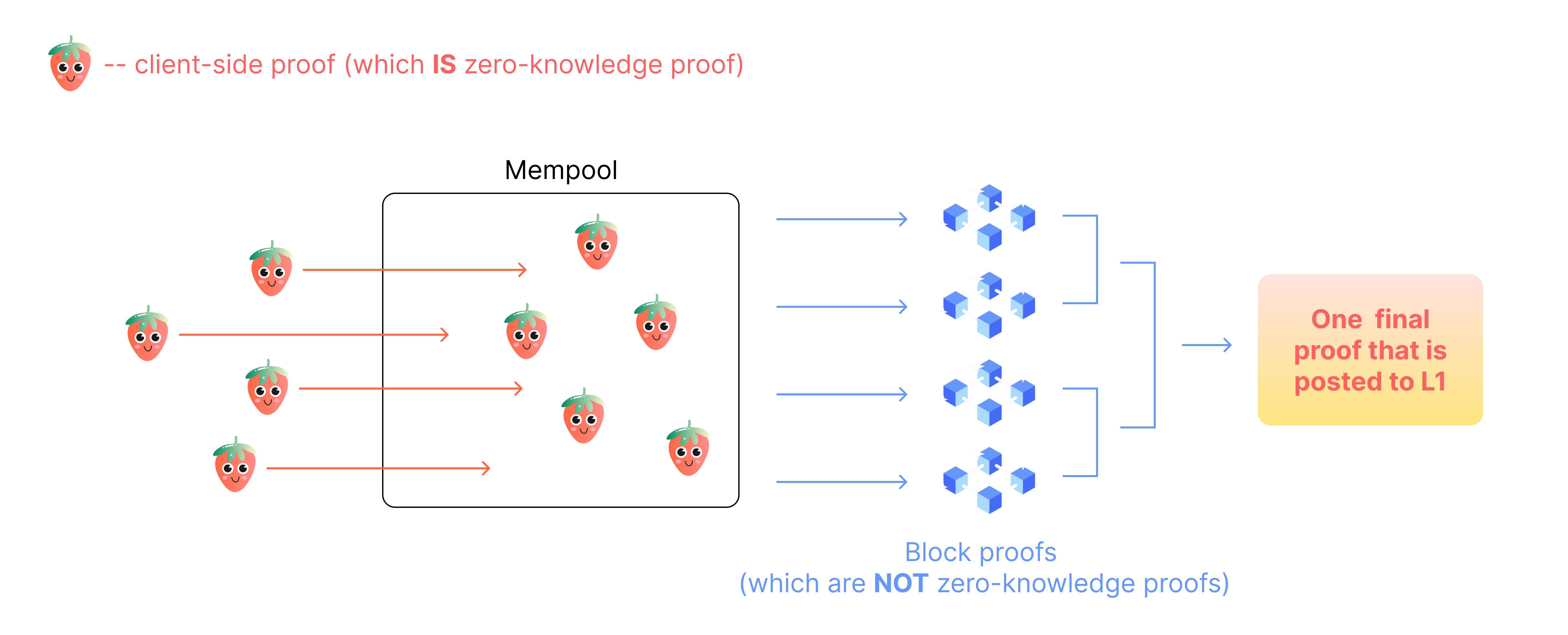
In this case, client-side proof is a zero knowledge proof of statement: the sequencer verifies the proof validity without any information about what was executed on the client-side, and is unable to retrieve any information about it.
After client-side proofs have been verified by the sequencer, everything is similar to a vanilla ZK-rollup mechanism as described in the previous section. That is to say, Aztec ZK-rollup first generates a number of client-side proofs (which are zero knowledge proofs) and then a block proof (which is not zero knowledge).

It’s not possible to add privacy ad-hoc to an already existing ZK-rollup. It should be designed to be private from the very beginning.
One first needs to give a precise definition of “privacy” as the statements proved, depending on the rollup design, may reveal unnecessary information and harm user privacy.
If builders want their dApps to interact with the external world; meaning that dApps aren’t monolithically private but instead allow some functions and variables to be private while some functions and variables stay public (e.g. necessary for AMMs, lending protocols, etc.), rollup state management becomes very non-trivial. Now it has to process public and private state updates separately. However, it’s exactly the latter approach that unlocks dozens of use cases we’ve been dreaming about for years! (Think programmable on-chain identity management and DeFi alternatives to conservative financial institutions).
As of today, Aztec is one of very few privacy-preserving L2s on Ethereum where privacy is provided by processing private information on the client-side. Check out this article to dive into client-side proof generation and this article to learn more about Aztec smart contracts anatomy allowing for hybrid private and public state management.
Ready to join Aztec’s building pioneers? Let us know by filling out this form.
Many thanks to Palla, Patrick, and Brecht for review.
In the ever-evolving landscape of digital privacy, the power of Zero-Knowledge Proofs (ZKPs) is revolutionizing how we protect and prove information. Noir, a leading language for privacy-first programmable privacy, is at the forefront of this innovation and is calling on you to help us enhance provable emails using Noir. This research campaign (NCR#1), running from August 8th - 25th, 2024 presents a unique opportunity to push the boundaries of privacy while creating novel solutions for secure email verification.
The rise of Programmable Cryptography and Zero-Knowledge Proofs offers unprecedented potential for trustless and private verification of information, cryptographically bridging data across silos. Imagine a world where you can prove ownership of an email address or an email received without revealing its content or personal details. This capability is not just a theoretical possibility, but a practical reality waiting to be unlocked through advanced research and development.
Aztec Labs has been a strong supporter of this vision, particularly with the ZK Email team's pioneering work. As a part of these continued efforts, we invite researchers, developers, tech enthusiasts, and anyone with creative ideas to propose a two-month research plan that explores ways to leverage Noir (and Aztec) to augment this work and its broader vision.
We’re looking for proposals focused on building end-user-oriented projects, including MVPs. Proposals focused on building developer tooling and technical/cryptography research are also welcome as long as their relevance to zkEmail is clear.
Multiple submissions are welcomed, however, to be considered, your proposal must meet the following criteria:
To participate, please head to our GitHub and submit your proposal using the following format:
Proposal submissions are open now and will close on August 25th, 2024. Our selection committee will pick two proposals that will receive up to US$40,000 in grants. Winners will be announced before September 5th, 2024, via GitHub Discussions and X.
Click here to get started on your proposal today.
We believe in the value of the real-world impact of top-tier research.
To ensure the security and quality of applying research outcomes, we’re onboarding audit partners to sponsor and provide auditing for the final implementations of selected proposals. Potential audit partners will be evaluated up to August 20th, 2024, and announced on GitHub by August 31st, 2024.
To learn more about how to get involved, please contact Savio or Lisa.
Join us in pioneering the future of privacy-first communication. Submit your proposal and be part of this transformative journey with Noir!